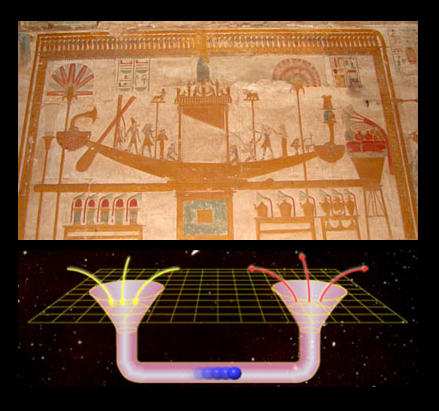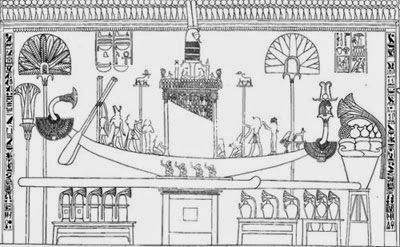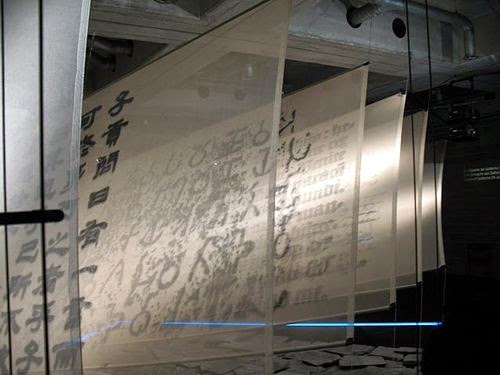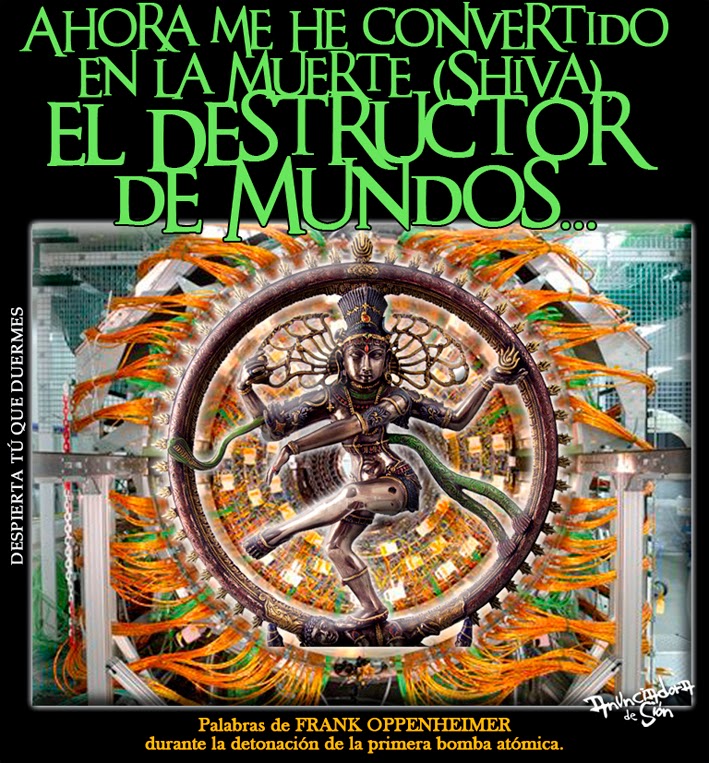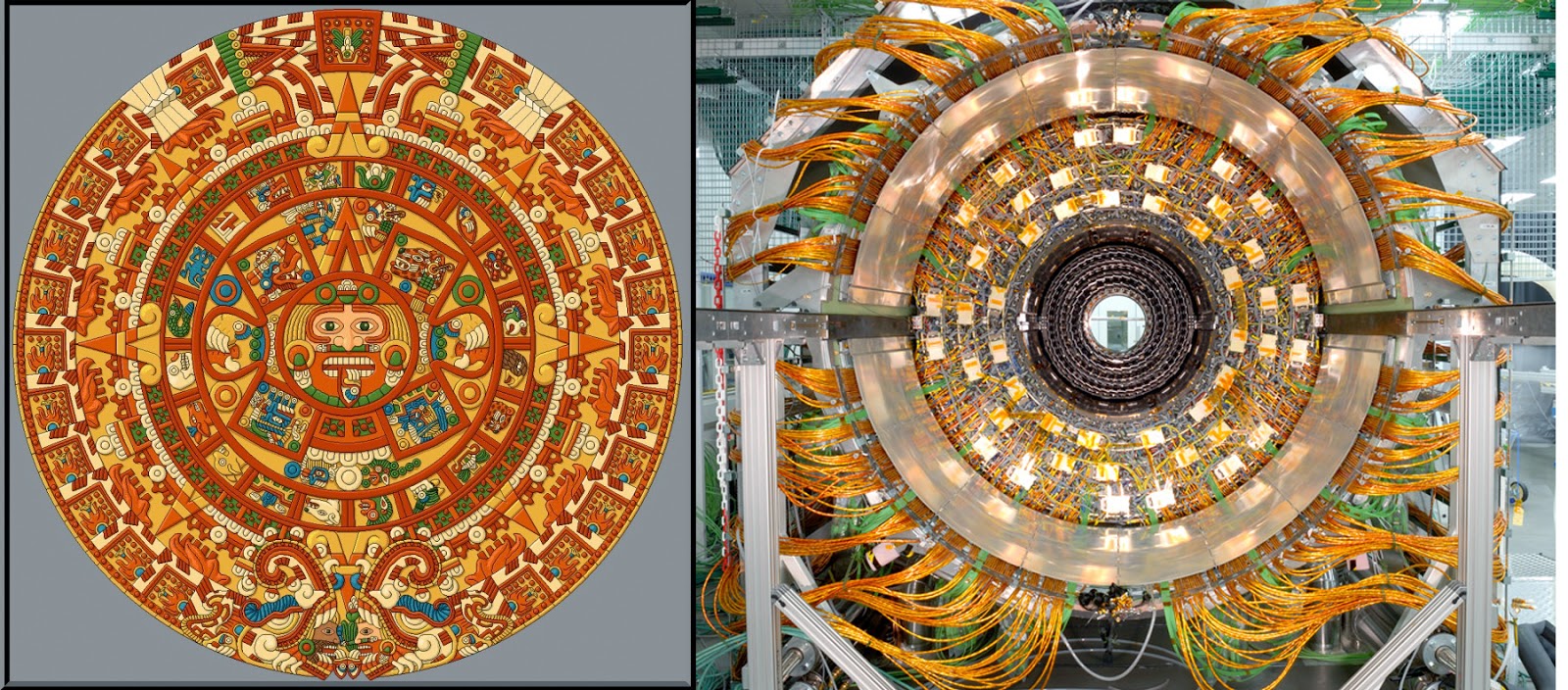|
|
General: PLACE DE LA CONCORDE LUXOR MADELEINE PALAIS BOURBON LOUVRE DA VINCI PARIS
Triar un altre plafó de missatges |
|
|
LAST UPDATED: 29 MAY 2024
The majestic Place de la Concorde played an essential part in French history. On many occasions, the square has been chosen for happy or sad national gatherings. One of the many prestigious stages of the Historical Axis, the square features a vast and elegant neo-classical ensemble from the 18th century. It connects the Tuileries Garden to the Champs-Elysées and the Madeleine to Palais Bourbon.
The magnificence of place de la Concorde
The Place de la Concorde plays a significant symbolic part along the Historical Axis. This magnificent vista runs through some of Paris’ most celebrated monuments and squares:
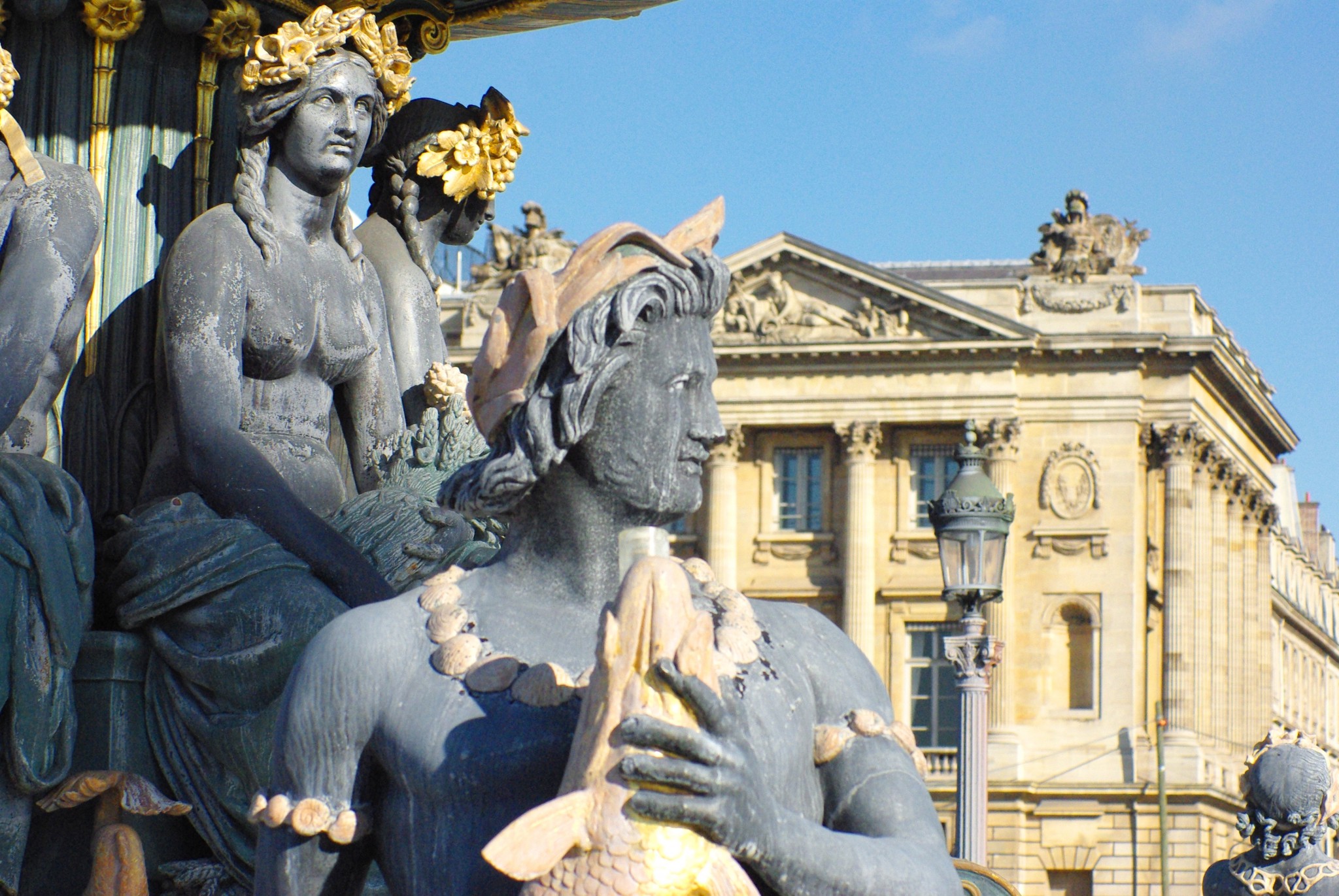 Fountain of the Rivers on Place de la Concorde © French Moments
The square takes the form of an octagon measuring 359 by 212 metres. The River Seine borders it to the South, and classical-style buildings to the North. The Egyptian obelisk stands at the centre of the square, flanked by two massive fountains.
The turbulent history of the square
In 1753 it was decided that the site should be designed as a square. This decision was taken during the reign of King Louis XV. At that time, many French cities had started or completed prestigious squares. They were commonly called “Place Royale” to the glory of the King: Montpellier, Nantes, Metz, Dijon or Bordeaux.
For instance, in the then-independent Duchy of Lorraine, the King’s father-in-law, Stanislas Leszczyński, commissioned the beautiful Place Stanislas in Nancy, which was well underway by 1753.
 Place Stanislas, a royal square in Nancy built in 1753-1755 © French Moments
A grand square dedicated to Louis XV
Gabriel, the King’s architect, was tasked with creating a magnificent square along the Historical Axis. It would stage an equestrian statue of Louis XV in the centre. The two monumental pavilions bordering the square’s northern side and divided by the Rue Royale were built in the Louis XV style: the Hôtel Crillon and the Hôtel de la Marine.
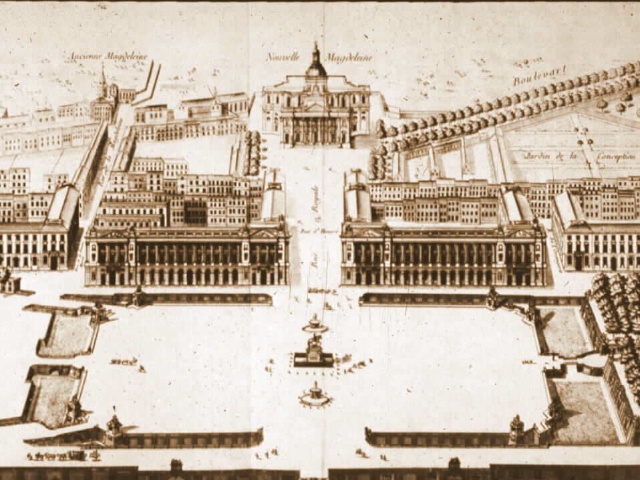 Plan of Gabriel for the Louis XV Square © French Moments
The tragic event of 30 May 1770
Misfortune struck the square on the occasion of the marriage of Dauphin Louis and Austrian archduchess Marie-Antoinette. On the 30th May 1770, people assembled for a celebration with much pomp and ceremony. A beautiful firework display was planned. However, following the accidental fall of a rocket, the crowd was panic-stricken, and 133 people were killed, trampled and choked.
During the Reign of Terror
But the worst was yet to come 20 years later with the uprising of the Revolution. Originally called ‘Place Louis XV’, the square was renamed in 1792 as ‘Place de la Révolution’. It became the stage for horrendous public executions by the guillotine.
During the Reign of Terror, the King, Queen Marie-Antoinette, and more than 1,100 victims were beheaded in less than two and a half years.
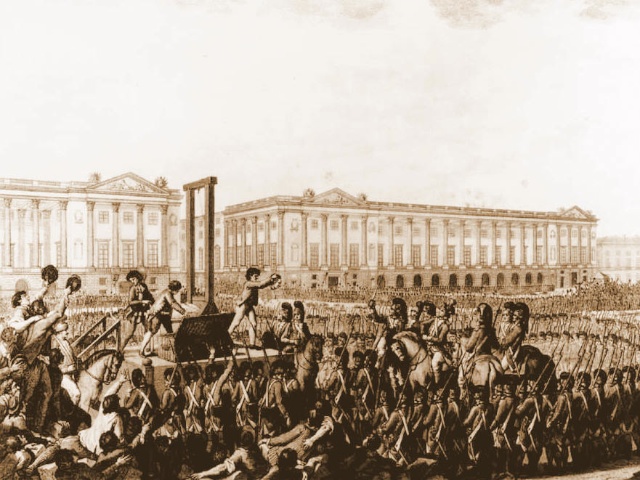 Execution of Louis XVI on Place de la Concorde
On 21st January 1793, Louis XVI was guillotined at the exact position of the statue of Brest, at the North-West angle.
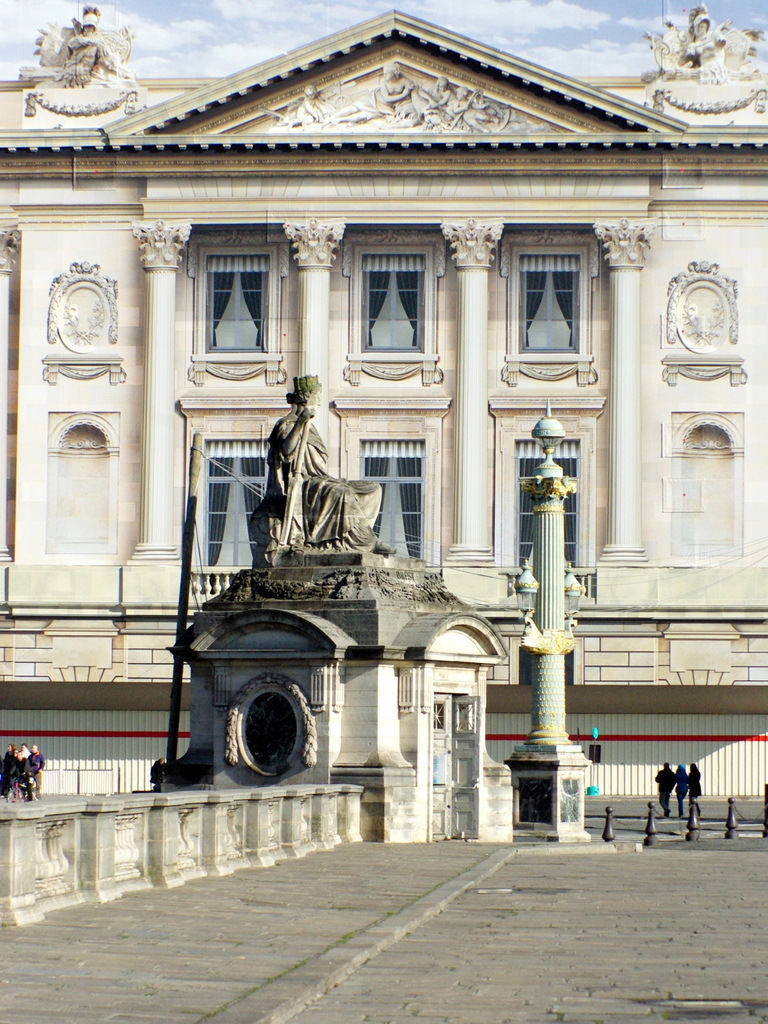 The monument of Brest, the spot where the guillotine was placed for Louis XVI’s execution © French Moments
From the 13th of May 1793, the “National Razor” was moved across the square near the railings of the Tuileries Gardens. Many more victims were beheaded: Marie-Antoinette (16th October), Madame du Barry, Danton, Madame Roland and Robespierre.
Place de la Concorde
Following those dreadful events of the Reign of Terror, the Directorate changed the square’s name in 1795 to one of reconciliation and hope: Place de la Concorde.
The Monuments of French cities
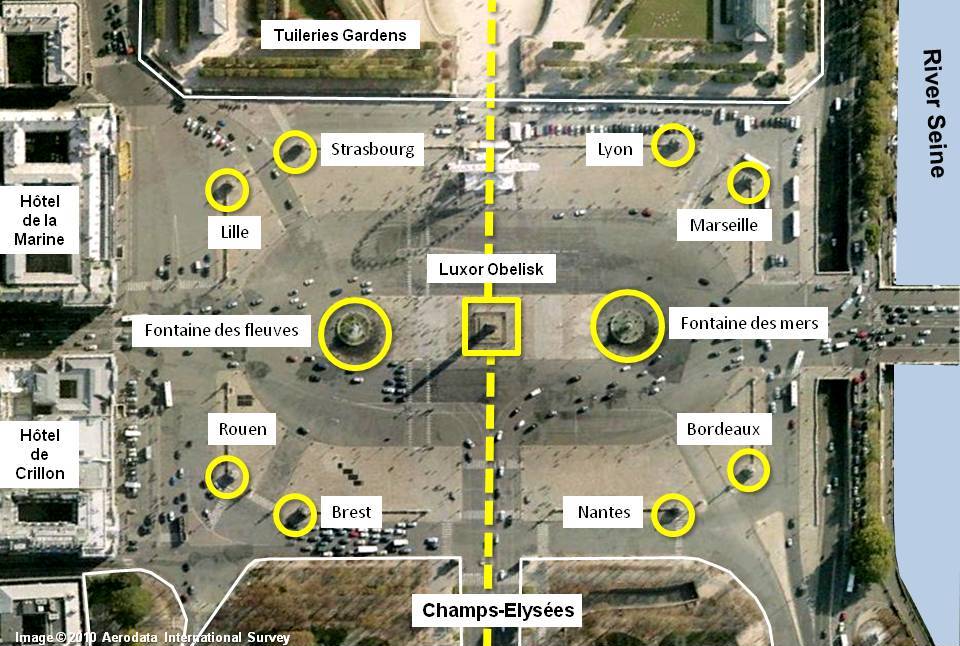
In the 1830s, architect Jacques Ignace Hittorff transformed the square by adding statues and fountains that can be seen today.
At each corner of the octagon formed by the Place, he erected eight stone monuments representing the French cities of:
 The Monument of Bordeaux © French Moments
The fountains
Hittorff also added two monumental fountains inspired by those in Piazza Navona in Rome:
- the Maritime Fountain (to the South, portraying the maritime spirit of France) and,
- the Fountain of the Rivers (to the North, representing the Rhône River and the Rhine River).
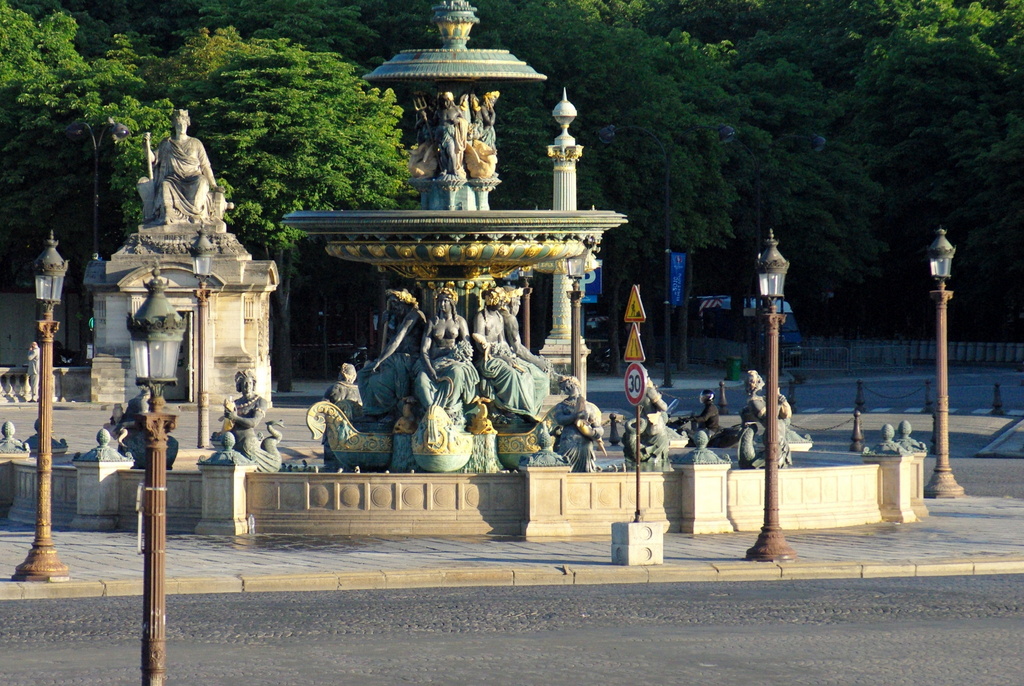 Fountain of the Rivers © French Moments
The Luxor Obelisk, Paris’ oldest monument
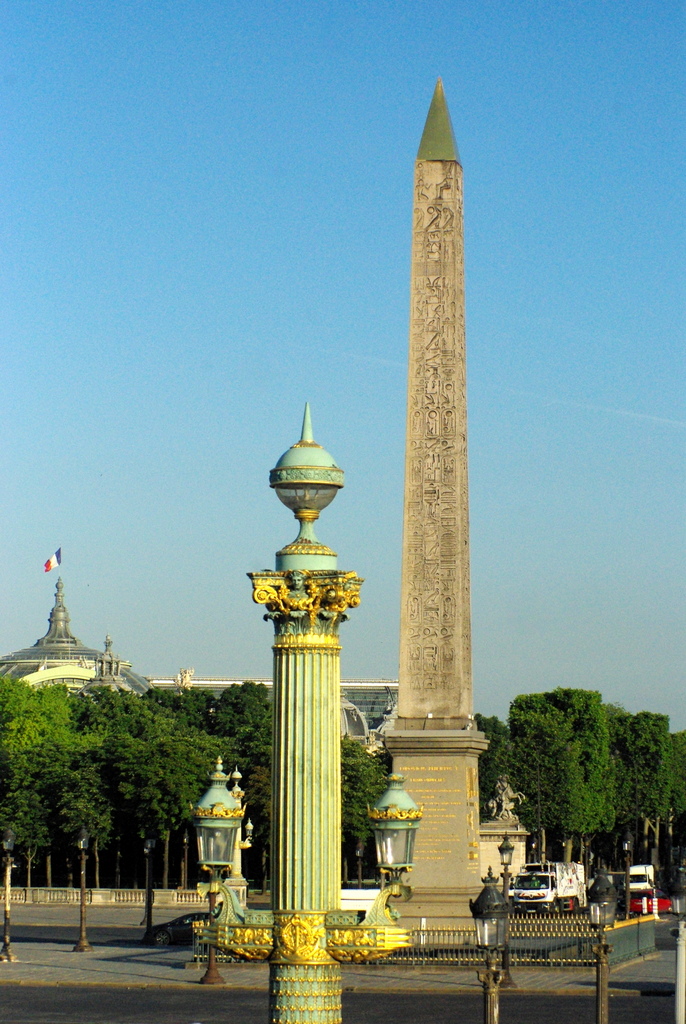 Place de la Concorde © French Moments
The Obelisk, ideally placed in the middle of the Place de la Concorde, is part of the strange geometrical layouts and alignments along the Historical Axis, evoking the symbols of Ancient Egypt.
Napoleon’s campaign to Egypt
To understand the reasoning that led the French to develop such admiration for Egyptology, let’s go back to Napoleon Bonaparte’s campaign to Egypt in 1798. The French Emperor-to-be attempted to conquer Egypt to counteract the English influence in the Middle East and India. The General was not coming to Egypt with soldiers only. As a newly elected French Academy of Sciences member, he took 167 savants to Egypt in 1798. There he founded the first modern scientific institute in Egypt: the Institut d’Egypte in Cairo.
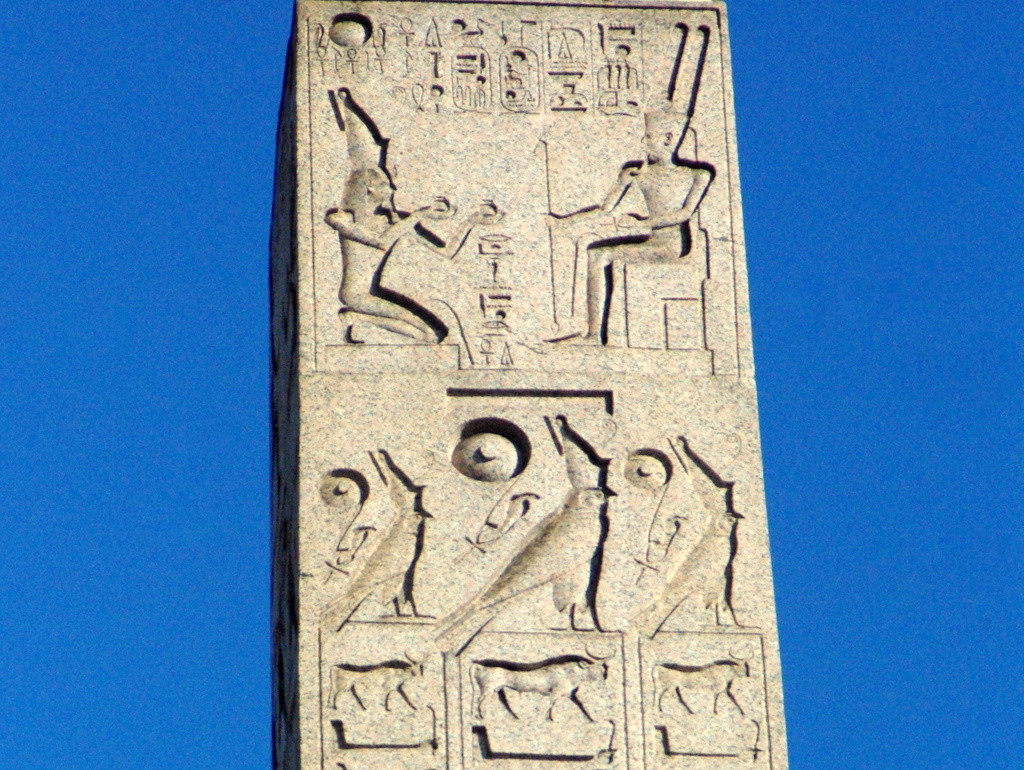 Obelisk, Place de la Concorde © French Moments
The Luxor obelisk on its way to France
King Charles X (1757-1836) showed an interest in Ancient Egypt and commissioned Jean-François Champollion (who deciphered the ancient hieroglyphs) to arrange for an obelisk to be returned to Paris.
In 1831, Mohammed-Ali, Viceroy of Egypt, offered France one of the two obelisks which guarded the entrance of the temple of Luxor in Upper Egypt. Both date back to Pharaoh Ramses II, the most powerful king of Ancient Egypt.
A unique ship, the Luxor, was designed to carry the obelisk to France down the Nile and across the Mediterranean Sea to the port city of Toulon and then by river to Paris.
In Charles X’s plans, the obelisk had to find its place on Place de la Concorde. That is the square built in honour of his grandfather and where his brother and sister-in-law were beheaded.
Raising the Obelisk on place de la Concorde
On the 25th of October 1836, 200,000 people gathered at the square to witness the lifting operation to raise the obelisk onto its pedestal.
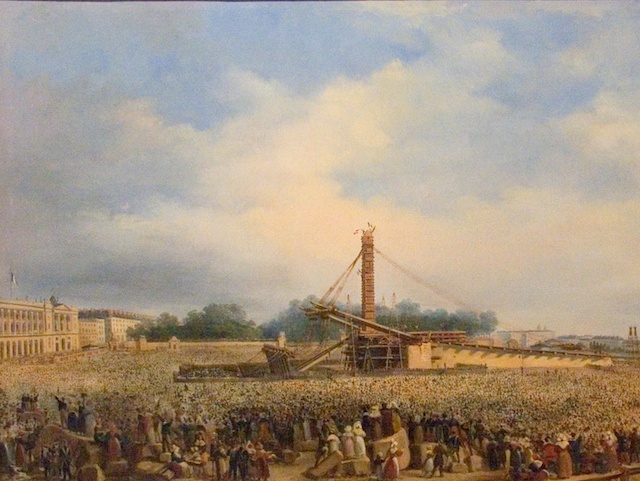 Erection of the Luxor Obelisk on Place de la Concorde in 1836. Painting by François Dubois
To the relief of supervisor Lebas and the assembled crowd, the event was a success. From that day, the “Obélisque de Louxor” sits enthroned in the centre of the square.
 The Obelisk seen from the entrance to the Tuileries Garden © French Moments
The oldest monument in Paris
Some 3,500 years old, the obelisk is the oldest monument standing in Paris. It is 23 metres tall and weighs 220 tons. However, the French capital was not the only European city to display an obelisk.
Other Egyptian obelisks in Europe
- The Romans transferred the one standing in Saint Peter’s Square in Rome to decorate the circus.
- Another specimen erected after that of Paris is in London (the obelisk of Tuthmosis III on the Victoria Embankment, better known as Cleopatra’s Needle).
- Without forgetting New York (a twin obelisk to the one in London, erected in Central Park).
The pyramidion
When the obelisk was carried to France in the 19th Century, its original cap had long disappeared. In fact, it was believed to have been stolen in the 6th century BC.
In May 1998, the French authorities decided to refurbish the obelisk by putting a copy of the missing gold-leafed pyramid cap on top, thanks to the initiative of Egyptologist Christiane Desroches Noblecourt. This pyramid cap is called a pyramidion. It is supposed to reflect the rays of the sun.
 The obelisk’s pyramidion © French Moments
In 1988, this tremendous Egyptian landmark was joined by another pharaoh-related structure along the Historical Axis: the modern Glass Pyramid in the Louvre, evoking the Great Pyramid of Giza.
A perpendicular perspective on the Historical Axis
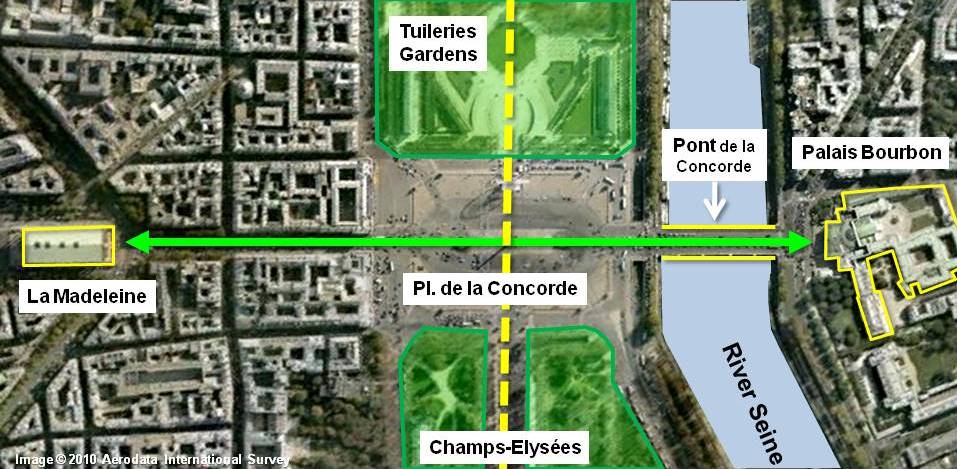
The Place de la Concorde set the stage for another North-South perspective, much shorter, perpendicular to the Historical Axis.
It features, on the South side, beyond the bridge “Pont de la Concorde” across the Seine:
In fact, both monuments match each other across the Place de la Concorde with their grand Classical-style porticos, evoking the design of Roman temples.
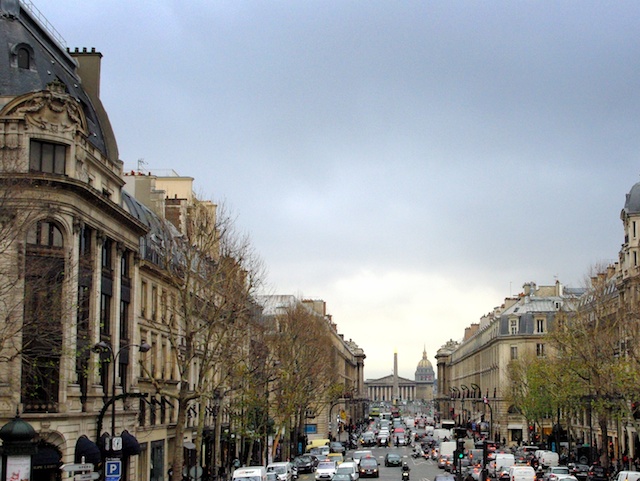 The great perspective from the Madeleine church towards the Bourbon Palace © French Moments
The 19th-century Madeleine Church strangely resembles a Roman temple and shares some similarities with the ancient ‘Maison Carrée’ in Nîmes.
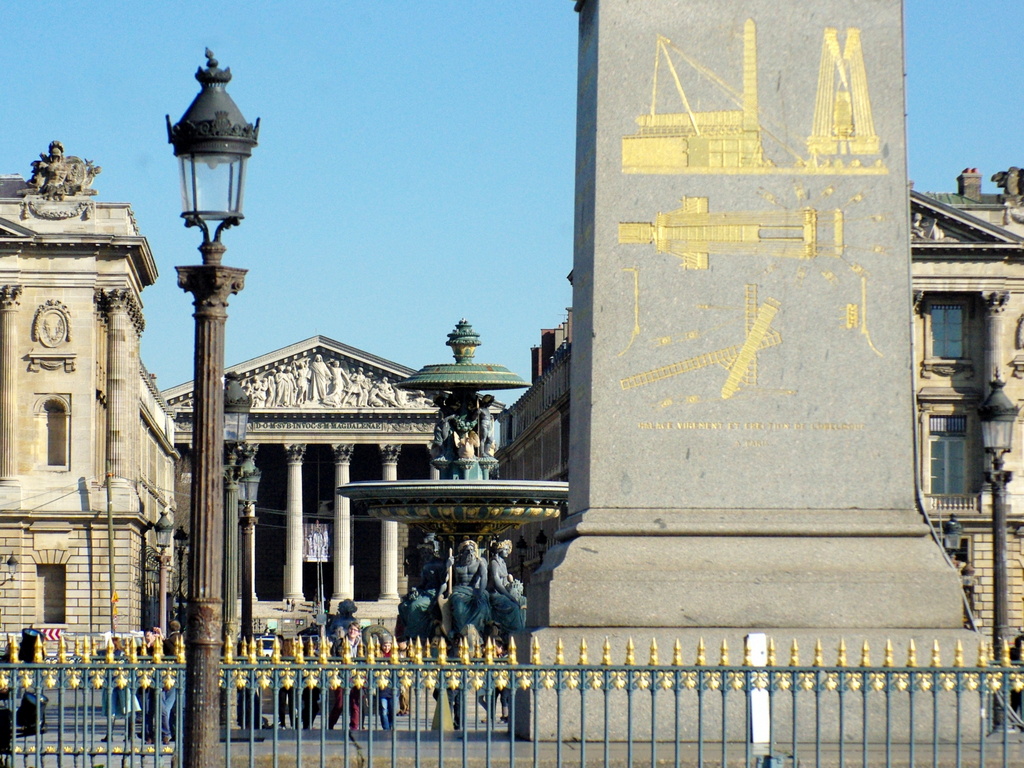 The Madeleine church seen from the square © French Moments
The Palais Bourbon housed the National Assembly, and its pedimented, collonaded front was inspired by the Madeleine Church at the far end of the short perspective crossing the Place de la Concorde.
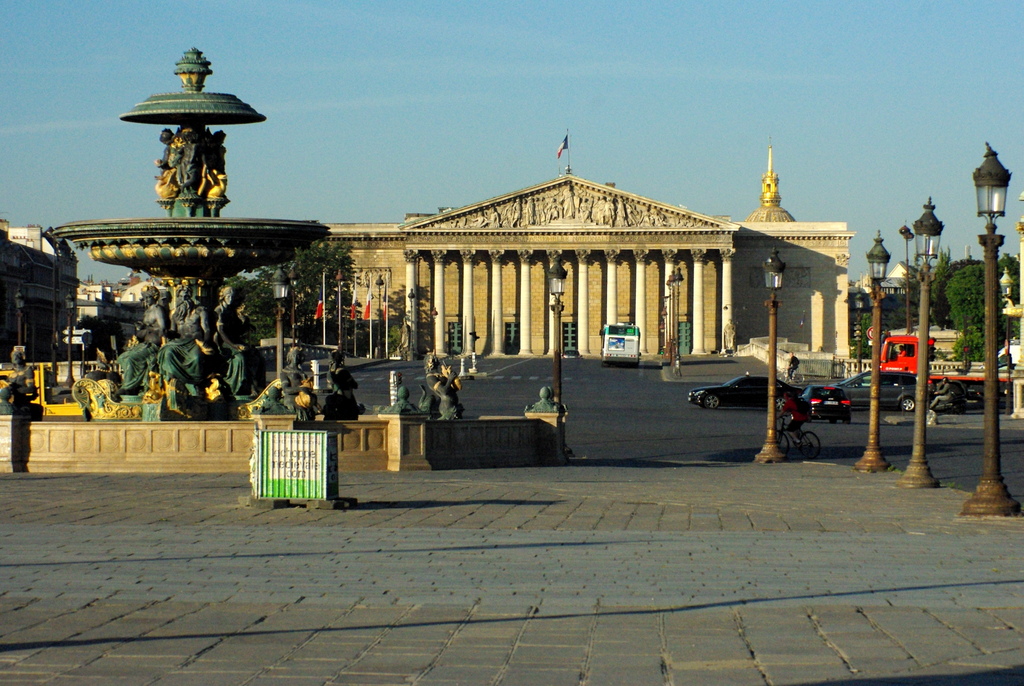 Palais Bourbon from the square © French Moments
The Pont de la Concorde
 Pont de la Concorde, Paris © French Moments
The Pont de la Concorde, crossing the Seine and linking the Place de la Concorde to the Palais Bourbon, was completed in 1791, with many of its stones taken from the dismantled Bastille fortress. When complete, it was said that the people of Paris could ride roughshod over the ancient fortress.
The view from the bridge stretches to the Eiffel Tower, the Alexandre III Bridge on one side, and the other to the Tuileries Garden and the Louvre.
More photos of Place de la Concorde
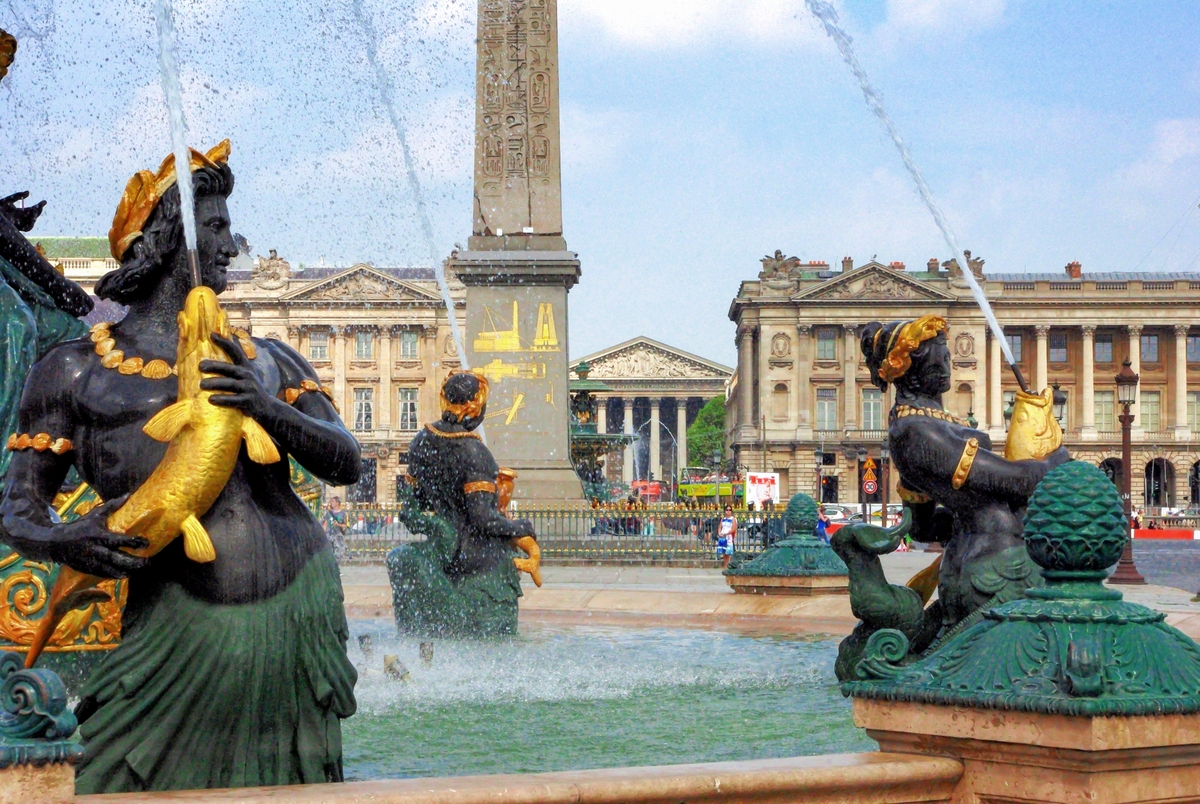 The fountain of the seas in Place de la Concorde © French Moments  The three needles of Paris! © French Moments  Place de la Concorde © French Moments 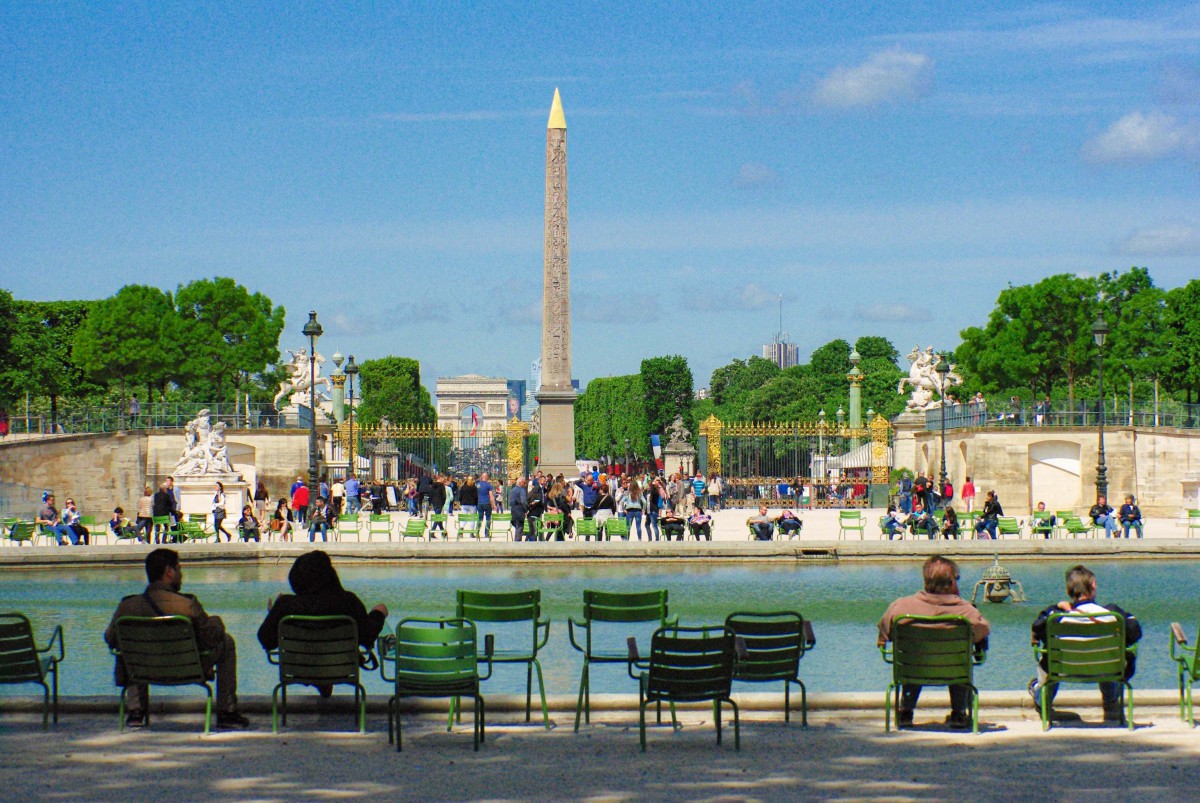 The Historical Axis of Paris in the Tuileries garden near Place de la Concorde © French Moments  Winter in Place de la Concorde, Paris © French Moments 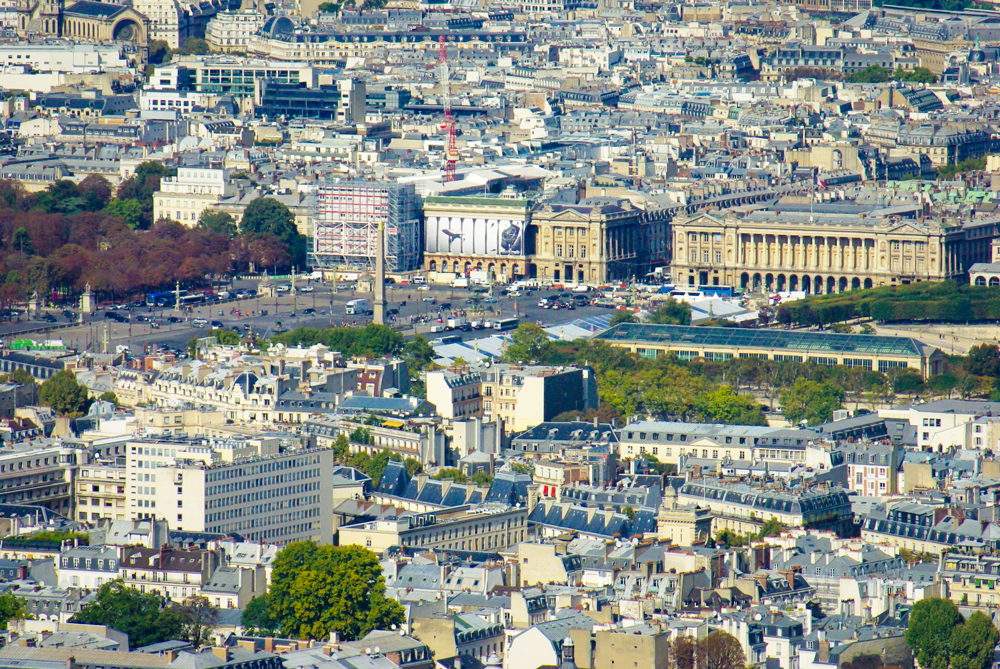 Place de la Concorde © French Moments
Until the mid-2010s, a Ferris wheel stood in the centre of the square during the Christmas period. It allowed taking beautiful pictures from the beautiful perspective of the Champs-Elysées.
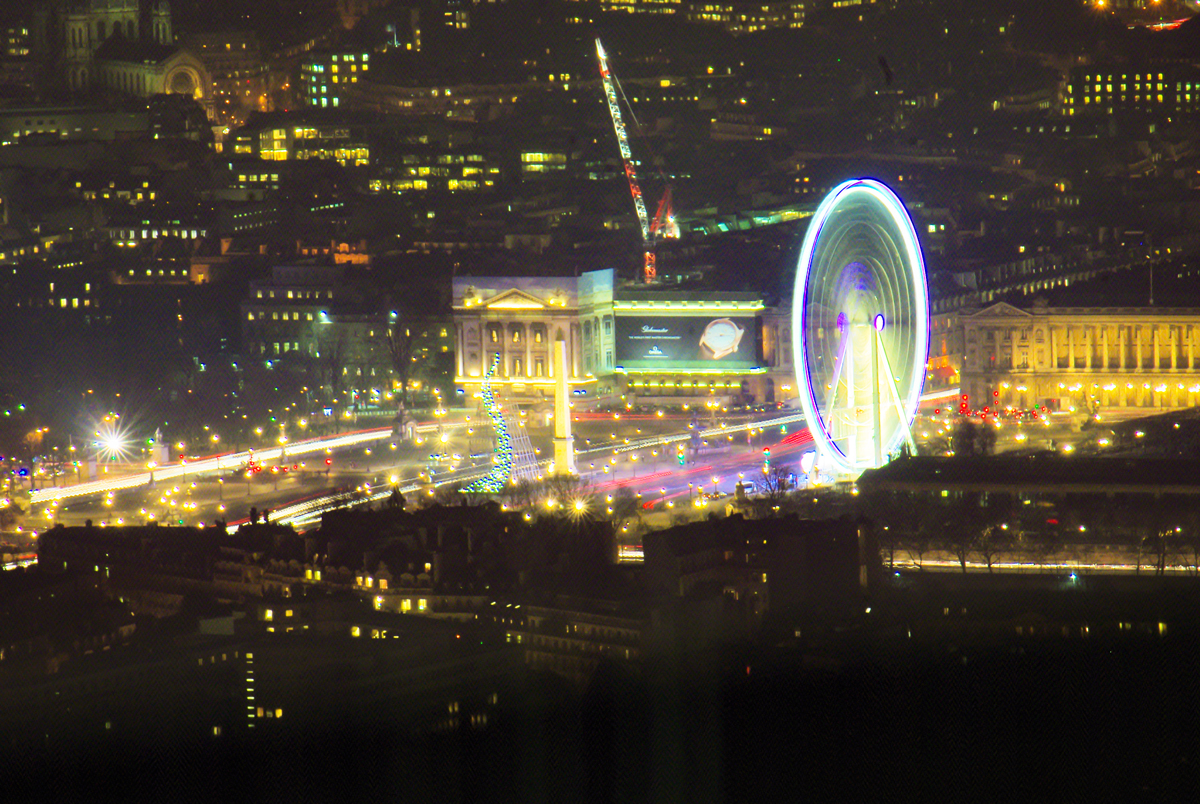 Christmas in Paris – Place de la Concorde © French Moments 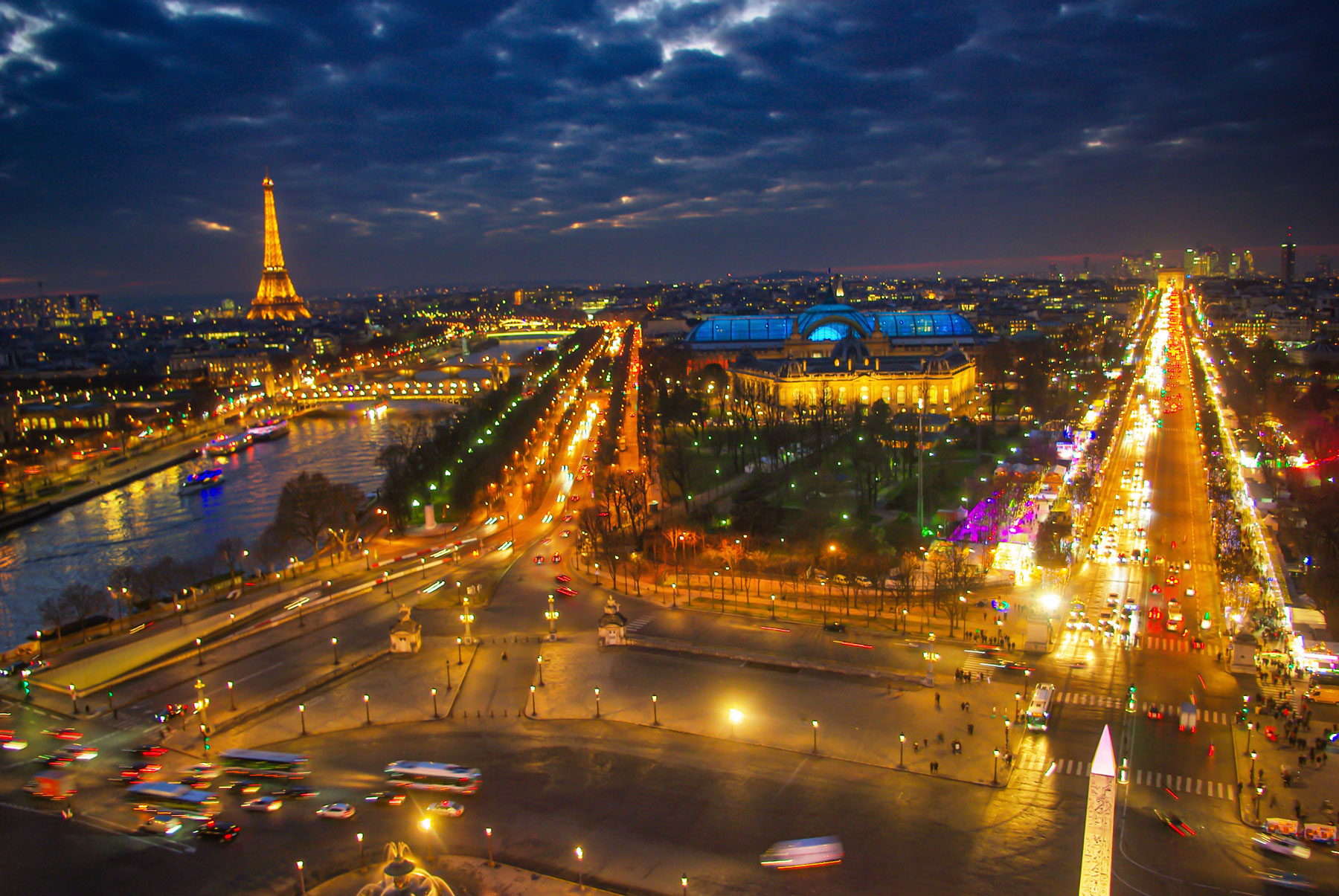 The view from the Ferris wheel © French Moments  The square at night © French Moments 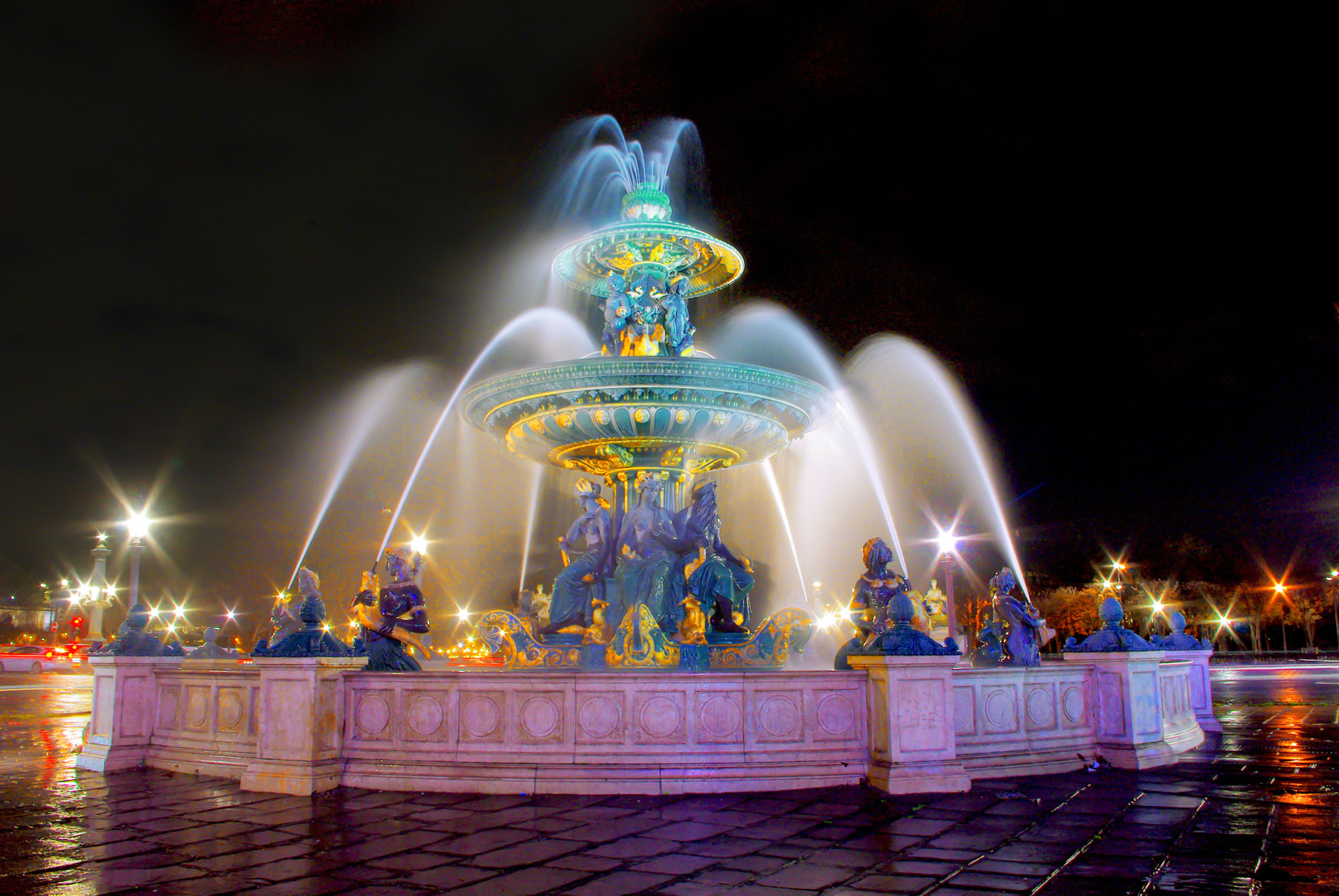 The fountain illuminated © French Moments 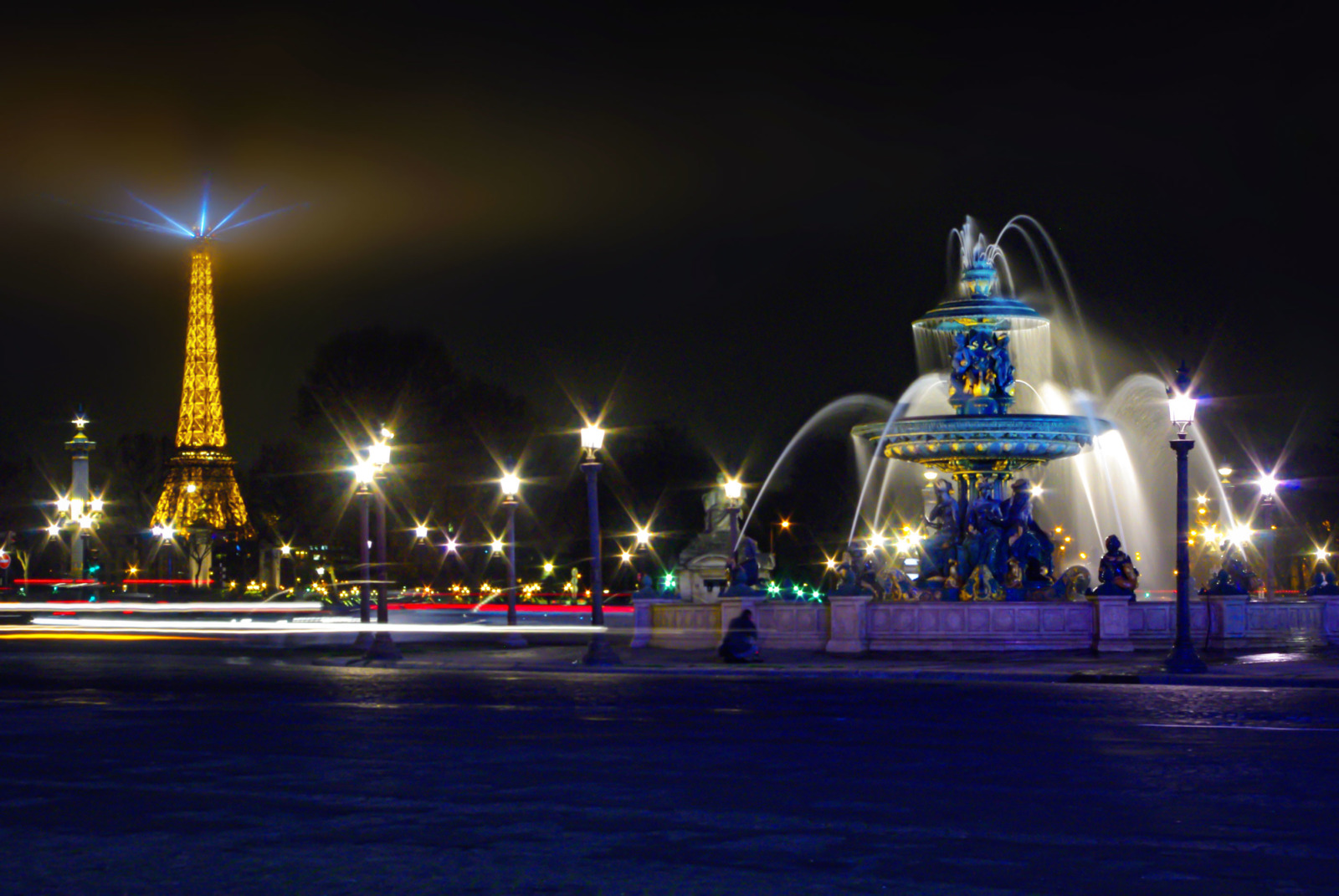 Place de la Concorde by night © French Moments
Pin it for later
Did you like what you read? If so, I invite you to leave a comment below. Tell us what the most exciting thing you learnt from the article was!
Also, make sure to pin the image below on Pinterest:
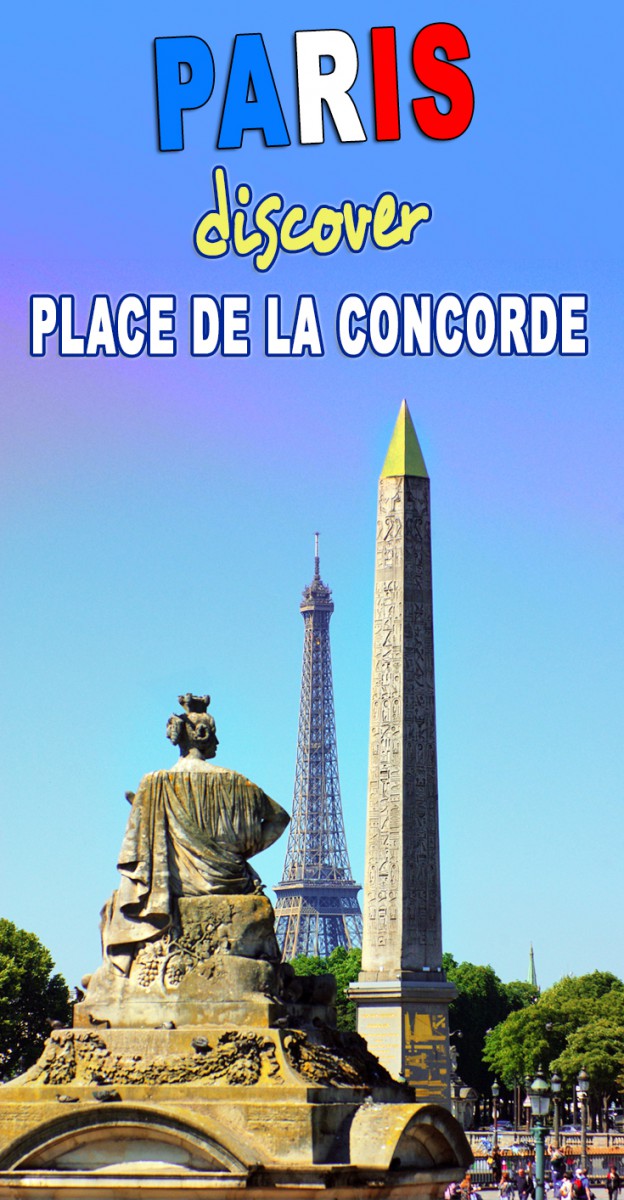
https://frenchmoments.eu/place-de-la-concorde-paris/ |
|
|
|
|
https://bestparisstrolls.com/stroll-16-concorde-madeleine-expiatoire/ |
|
|
|
|
-
On October 25, 1836, the Luxor Obelisk was erected in the center of the Place de la Concorde by order of King Louis-Philippe. Offered to France by the Viceroy of Egypt as a token of goodwill,
I too this picture today was i was passing through the area and the sun was so magnificent…
|
|
|
|
|
- "[T]his makes it rather clear that Janet Jackson, via exposing her right breast and her juxtaposition with Beyonce
 (representing the American spirit), was 'designed' to embody Lady Justice/Liberty - signifying or prompting the rebirth of the spirit of 'Columbia'. The prevalent 'blackness' additionally alludes to the pertinence of another related figure Mary Magdalene, recently made popular by the huge success of the book The Da Vinci Code, as this biblical/esoteric 'wife' of Jesus - embodying the feminine and sexuality - was sometimes portrayed as the 'Black Madonna'." (representing the American spirit), was 'designed' to embody Lady Justice/Liberty - signifying or prompting the rebirth of the spirit of 'Columbia'. The prevalent 'blackness' additionally alludes to the pertinence of another related figure Mary Magdalene, recently made popular by the huge success of the book The Da Vinci Code, as this biblical/esoteric 'wife' of Jesus - embodying the feminine and sexuality - was sometimes portrayed as the 'Black Madonna'."
https://www.goroadachi.com/etemenanki/lucifer-timecode-2.htm |
|
|
|
|
LAST UPDATED: 27 NOVEMBER 2024
You may know Paris for its cathedral Notre-Dame, the Eiffel Tower, its café culture and its amazing museums and art galleries. The French capital is also famous for its fantastic perspective that runs from the Louvre to La Défense. This is the ‘Voie Triomphale’, aka the Historical Axis of Paris.
This line is one of the most prestigious perspectives in the world. In fact, its design has inspired cities such as Buenos Aires, Washington DC, New Delhi and Canberra. In this article, we’ll learn more about the Historical Axis of Paris. We’ll discover the stunning monuments and I reveal to you some stunning facts.
What is the Historical Axis of Paris?
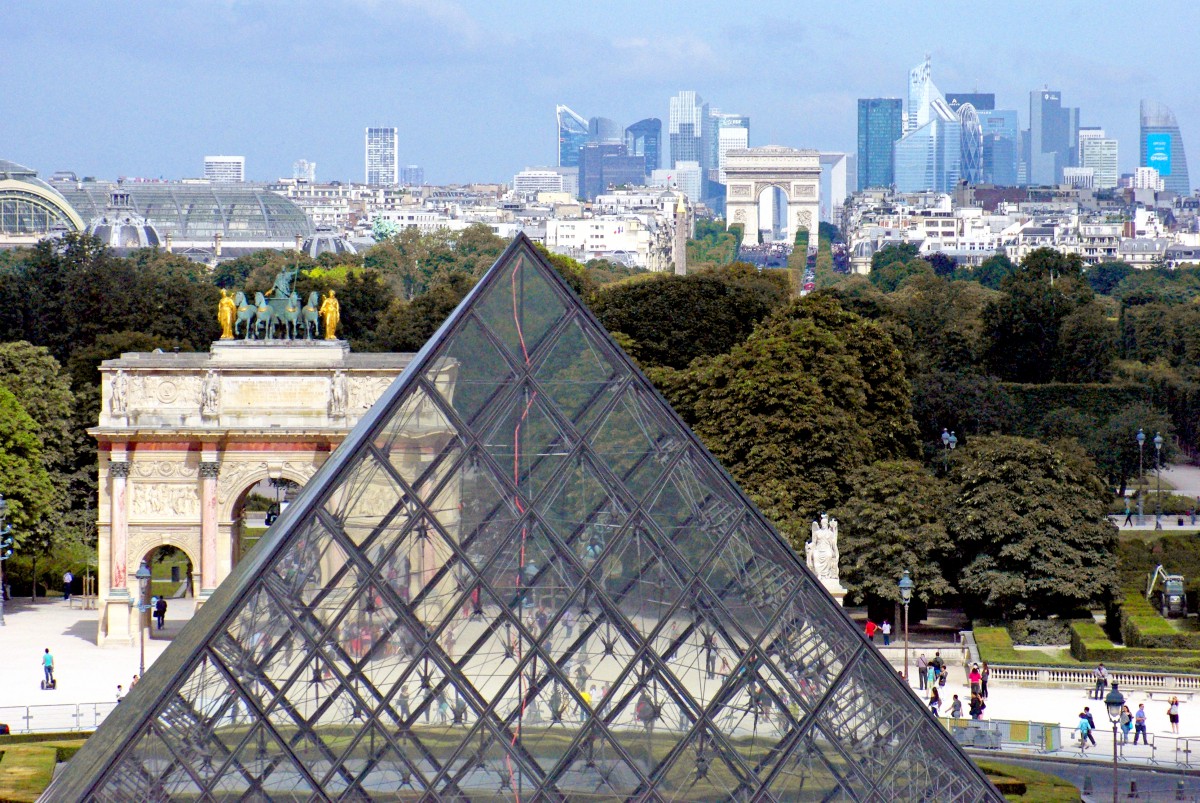 The glass pyramid and the historical axis of Paris © French Moments The glass pyramid and the historical axis of Paris © French Moments
The Historical Axis, also known in French as “Axe Historique”, “Voie Triomphale” or “Voie Royale” is orientated on a 26° angle.
It follows the course of the Sun from its rising in the East to its setting in the West.
Oddly, this angle of orientation is the same as that of Paris’ Notre-Dame Cathedral, some 1,000 metres away from the Louvre Palace.
More than just a series of monuments placed along the axis, it seems that a complex symbolism was at work in the mind of the successive urban planners.
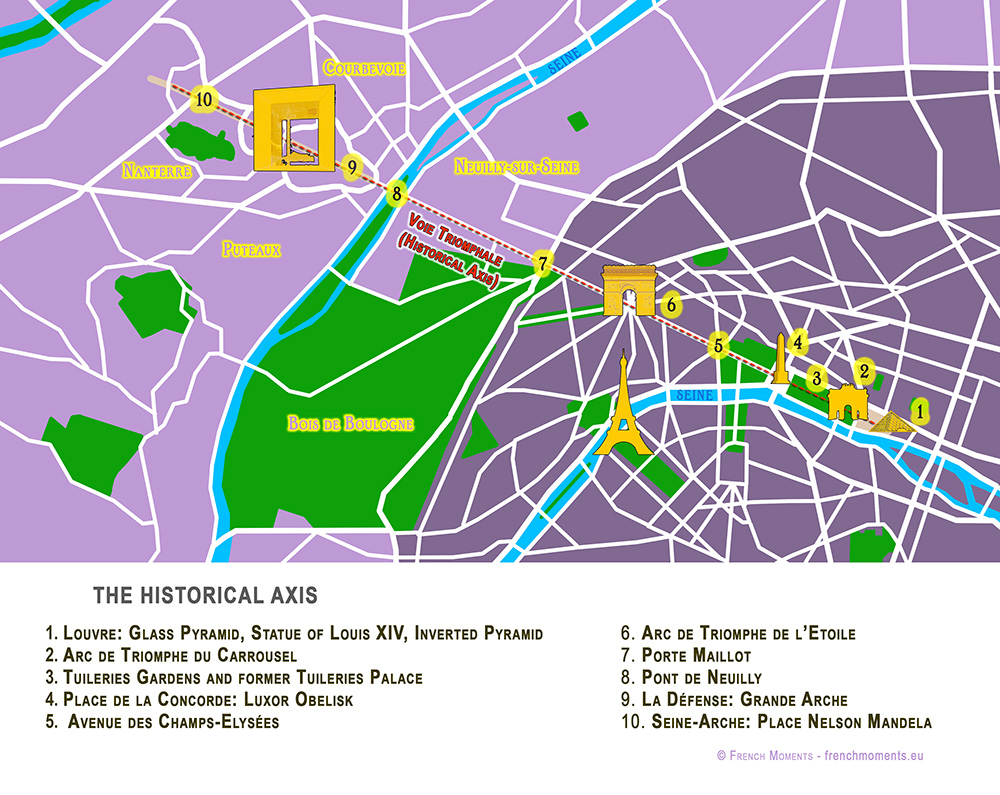
The Historical Axis runs through some of Paris’ most celebrated monuments and squares:
Let’s move along the Historical Axis of Paris, from East to West, starting from the Louvre.
The Palace of the Louvre
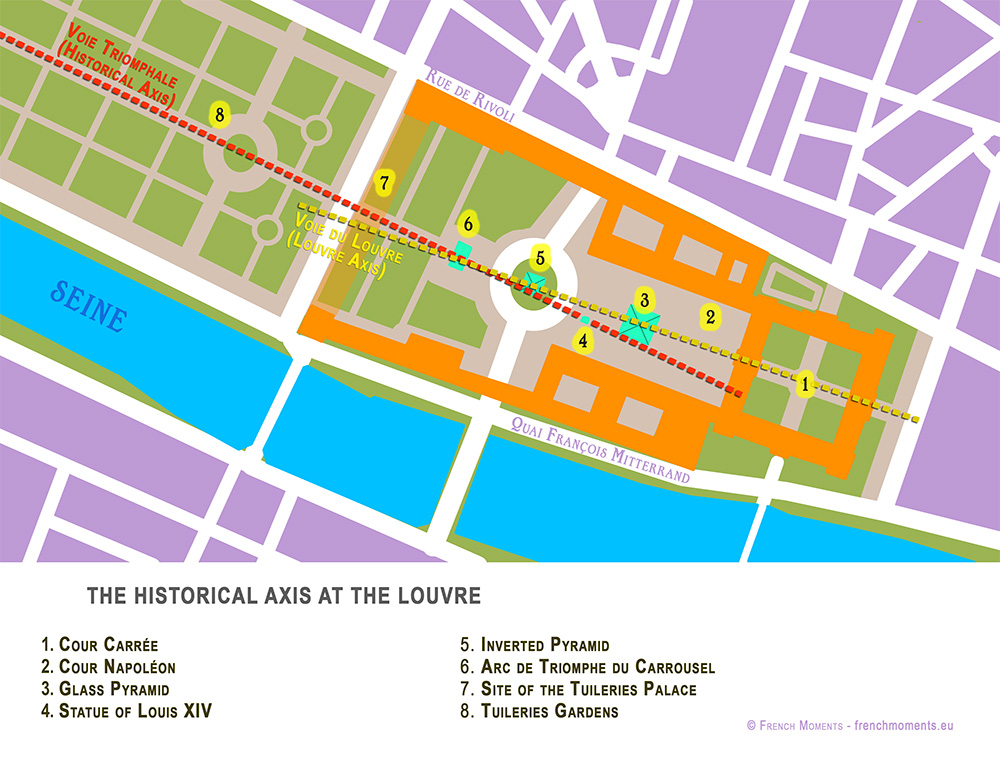
Today the great perspective starts at the Louvre, immediately beyond the Church of St Germain l’Auxerrois.
The crab-shaped Palace was the main residence of the kings of France until 1682, when Louis XIV, the ‘Sun King’, moved his court to Versailles. It currently houses one of the world’s most wonderful museums in a complex that is known as the “Grand Louvre”.
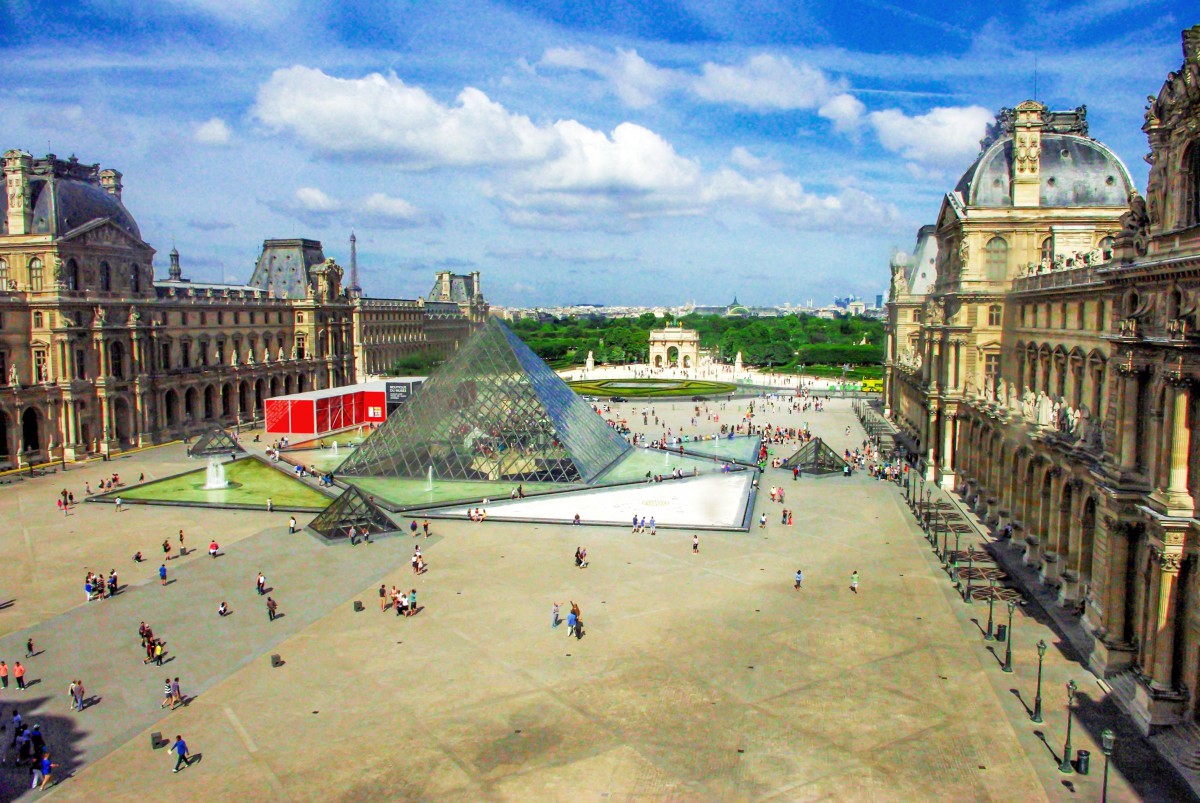 The Louvre today © French Moments The Louvre today © French Moments
The controversial glass pyramid of the Louvre
President François Mitterrand left his mark with his pharaonic project of “Le Grand Louvre”. He wished to complete it for the bicentennial celebration of the French Revolution in 1989. The titanic project comprised of major renovation works and the construction of a new landmark along the Historical Axis: the celebrated (and controversial) Glass Pyramid.
But if you look closer, you’ll notice that the glass pyramid is not aligned with the other monuments on the Historical Axis.
That’s why something had to be added in this vast courtyard of the Louvre…
https://frenchmoments.eu/historical-axis-of-paris-la-voie-triomphale/ |
|
|
|
|
Place de la Concorde
This square used to be named Place Louis XV after the king who built it, including the two magnificent buildings looking on the square, which were royal property. In the middle of the square used to stand a statue of the same king, which was of course destroyed during the French Revolution. The obelisk, a gift from Egypt, came later in 1836.
With 19 acres, this is the largest square in Paris, therefore it was used for celebrations gathering large crowds: a notable one was a banquet for the marriage of the future Louis XVI with Marie-Antoinette. During that event, fireworks ignited a fire which caused panic among the thousands of people attending and over one hundred of them died crushed by the mass movement.
During the reign of terror, one of the guillotines was placed there for executions of high profile personalities: including the king and queen, and many members of the revolutionary government like Danton and Robespierre. By the foot of the obelisk, a plaque serves as a reminder of the events.
https://www.parisology.net/place-de-la-concorde |
|
|
|
|
|
Through this guided historical walk, walk the neighborhoods of Saint-Germain and the Bourbon Palace in search of visible or hidden traces of Freemasonry in the capital. These scattered symbols illustrate the taste of secrecy that characterizes the Masonic initiation rite: its new members are introduced by cooptation and are required not to reveal the identity of other members throughout their initiation. The Masonic secret has always fueled fantasies and misconceptions about this order born in Great Britain in 1717. Your passionate guide will teach you to distinguish the signs and decipher the truth from the false to focus on the historical origin of Freemasons, their organization, the main figures, and above all, their importance in the formation of our society.
https://www.tripadvisor.co.uk/AttractionProductReview-g187147-d19100135-Freemasons_myths_and_revelations_about_a_secret_society-Paris_Ile_de_France.html
|
|
|
|
|
EL CERN, NI CIENCIA NI MAGIA: ALQUIMIA
Hace años que vengo siguiendo las actividades Illuminati en diferentes ámbitos (social, cultural, científico, educativo, político, etc.), y siempre hay algunos puntos que permanecen "oscuros" por un cierto tiempo, hasta que finalmente desvelamos su real significado e intencionalidad. El Gran Colisionador de Hadrones, GCH (en inglés Large Hadron Collider, LHC) del CERN, junto con el Acelerador Relativista de Iones Pesados o RHIC por sus siglas en inglés (Relativistic Heavy Ion Collider), han sido algunos de los "avances" científicos que hemos tenido entre ojos, vigilando su desarrollo para descubrir cuál es el objetivo que se esconde por detrás de ellos, detrás de la "inocente" propuesta de "recrear el segundo previo al Big Bang".
Por cierto, la teoría del Big Bang fue elaborada por un jesuita... ¿sabían? Este no fue Papa pero seguro lo canonizan...
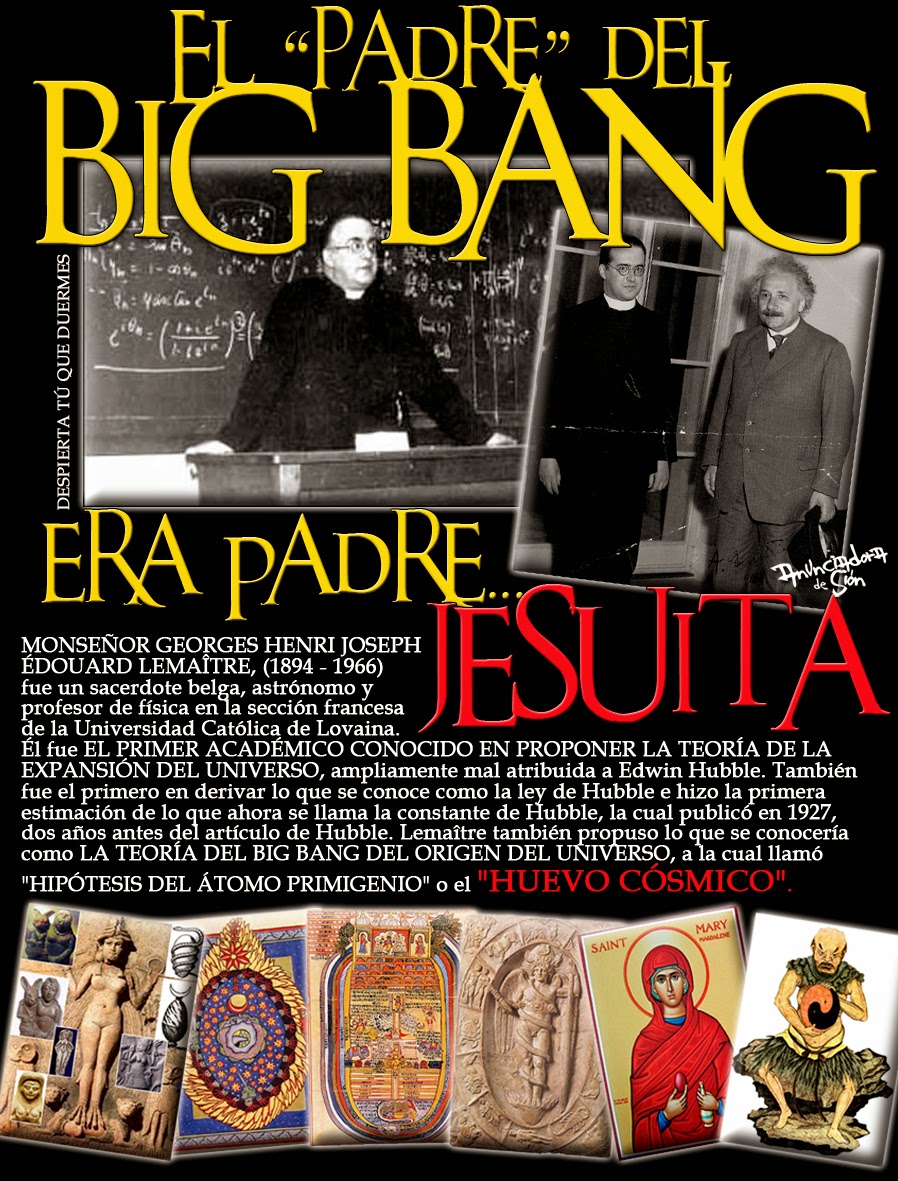
Monseñor Georges Henri Joseph Édouard Lemaître, (1894 - 1966) fue un sacerdote belga, astrónomo y profesor de física en la sección francesa de la Universidad Católica de Lovaina. Él fue el primer académico conocido en proponer la teoría de la expansión del universo, ampliamente mal atribuida a Edwin Hubble. También fue el primero en derivar lo que se conoce como la ley de Hubble e hizo la primera estimación de lo que ahora se llama la constante de Hubble, la cual publicó en 1927, dos años antes del artículo de Hubble. Lemaître también propuso lo que se conocería como la teoría del Big Bang del origen del universo, a la cual llamó "hipótesis del átomo primigenio" o el "huevo cósmico". (Demasiado "mitológico" para mi gusto...). Un huevo cósmico o huevo del mundo es un tema mitológico y cosmogónico usado en los mitos de creación de muchas culturas y civilizaciones. Típicamente el huevo cósmico representa simbólicamente un comienzo de algún tipo.
Irónicamente la teoría del Big Bang se atribuye generalmente a Albert Einstein, quien fue el principal detractor de Leimatre hasta que, años después, comprobó que el religioso belga había acertado en los cálculos astronómicos, de alta complejidad, y juntos profundizaron las investigaciones. (De hecho, el "genial" Alberto anduvo robando por todas partes... también a Tesla).
Volviendo al tema central del CERN, he llegado a la conclusión, después de tomar en cuenta toda la información y las personas asociadas con el proyecto, que no es OTRA COSA SINO UNA APLICACIÓN MÁS DE LOS ILLUMINATI DE UNA ANTIGUA TECNOLOGÍA OCULTA DE LOS ÁNGELES CAÍDOS. Los Illuminati están obsesionados con el cumplimiento de lo que George Bush (padre) llamó el "cumplimiento de un antiguo sueño", en referencia a la vuelta a los días anteriores a Noé, cuando los híbridos gigantes habitaban en la tierra. El restablecimiento del estado de la Atlántida de los reyes filósofos.
Con todo, una de las cosas que más llamó la atención cuando la creación del CERN, y que la mayoría de la gente no conseguía entender, fue CUÁL PODÍA SER LA RELACIÓN ENTRE UN COLISIONADOR DE HADRONES "TECNOLÓGICO Y CIENTÍFICO" Y UNA ESTATUA DEL DIOS SHIVA, "EL DESTRUCTOR", COMPLETAMENTE MÍSTICO Y MITOLÓGICO.
.jpg) |
| Observen el círculo que rodea al dios Shiva en su danza, y compárenlo con el acelerador de partículas. |
Ahora bien, lo interesante de todo esto es que algunos han relacionado todos estos elementos con lo que se conoce popularmente como Stargate, o portales ("VORTEX-GATE... PROCURANDO LA PUERTA DE SALIDA"). Hay varias teorías acerca de si el CERN es o no un Stargate. Pero vemos un poco acerca de lo que es conocido por los amantes de lo paranormal como "el dispositivo de Osiris", el Ta-Wer. Según los estudiosos, el Ta-Wer era un solo un símbolo místico que representaba la conexión entre Abydos (ciudad egipcia) y un lugar mítico en el mundo subterráneo, interpretado como la "Tierra de los muertos".
Bueno, es un sentimiento común entre los investigadores de ovnis que el Ta-Wer representado en algunas imágenes, en las paredes del templo de Abydos, es una estructura que podría ser parte de un gran dispositivo que activa portales dimensionales, puertas estelares o agujeros de gusano.
Arriba pueden ver un modelo de agujero de gusano cósmico en comparación con el "dispositivo de Osiris", que coincide con la teoría de Kurt Gödel, que por el hecho de que nada puede viajar más rápido que la luz, un "atajo" podría ser abierto en ciertas coordenadas del espacio, para conectar dos puntos distantes. Una enorme cantidad de energía que produciría una enorme cantidad de gravitación que podría "doblar" el espacio, formando dos conos de luz interconectados por un túnel espacio-tiempo donde podría pasar la materia.
La historia oficial: El LHC es un acelerador de partículas, construido para emitir protones a muy alta velocidad y en direcciones opuestas, para que choquen entre sí, creando una enorme cantidad de energía capaz de reproducir las condiciones cósmicas similares a aquellas que generan fenómenos tales como la materia oscura, la antimateria y en última instancia, la creación del universo hace miles de millones de años. El equipo científico mantiene la velocidad de rayo hacia arriba, entre el 3,5 y 12 TeV (Teraelectron voltios) para llegar a una energía de colisión alrededor de 90 veces a más de 500 TeV.
La historia "oculta": De acuerdo con la Prof. Irina Aref'eva y el Dr. Igor Volovich, ambos físicos matemáticos en el Instituto de Matemáticas Steklov en Moscú, las energías generadas por las colisiones subatómicas en el LHC pueden ser lo suficientemente potentes como para rasgar el espacio-tiempo, generando agujeros de gusano. Lo mismo opinan otros físicos (ver aquí).
Es una idea común al 99% de los físicos "fuera del sistema CERN", que el LHC puede producir suficiente energía como para abrir agujeros de gusano, lo que lo convierte en un dispositivo STARGATE enorme. Lo que quiero decir es que la "búsqueda de la partícula de Dios" es una bandera falsa, una tapadera para ocultar OTRA COSA... para variar.
Además de todas estas cosas, como cereza del postre, nos encontramos con los siguientes paneles dentro de las instalaciones del LHC:
Esto es MUY raro... las fotos que ven arriba fueron tomadas DENTRO de la instalación LHC. Se trata de extraños paneles con escritas antiguas, montados sobre una estructura y con algún tipo de haz de luz azul que los rodea, algo que parece ser un sensor de movimiento o cosa parecida. Algunos paneles parecen escritos en mandarín antiguo, otros tienen caracteres árabes, otro en hebreo, otro en sánscrito y otro contiene unos caracteres muy extraños, que no se parecen con nada que haya visto antes. En la India, las únicas personas que leen y escriben en sánscrito, son los estudiosos de los Vedas y los Upanishads, las escrituras escritas en el "lenguaje de los dioses". ¿Por qué estos paneles tienen sensores de seguridad, por qué están en el CERN, y para qué sirven?
Bien, pero las referencias místico-mitológicas no terminan con el antiguo Egipto. Ya conocemos la historia de Nimrod, que construyó una torre que fue diseñada para ser una escalera o puerta de entrada al cielo, la famosaTorre de Babel. Según la mitología tradicional, Nimrod quería conocer a Dios y entender su funcionamiento. Su torre era, literalmente, una escalera a las estrellas, una manera de entrar en la dimensión en la que Dios habitaba.
Hay ocultistas y mitólogos como William Henry que han afirmado que los antiguos como Nimrod y otros utilizaron estas torres y puertas estelares. Las torres crean agujeros de gusano y los dioses de las estrellas pasarían a través de ellas. Pero, por supuesto, a Dios no le gustó la idea y confundió el idioma de la gente de Nimrod. En contrapartida, Nimrod ORGANIZA LA MASONERÍA. Ellos continuaron construyendo estos portales estelares y templos.
A lo largo de la historia antigua ha habido muchos relatos de dioses que viajaban de un lugar a otro utilizando intrincadas maquinarias que los llevarían de una dimensión a otra. Hay historias de la antigua Sumeria que hablan acerca de los llamados "dioses", llegando a través de una puerta estelar doble con columnas, y existen tallas que han representado tal hazaña.
Ha habido muchos intentos de abrir agujeros de gusano y, al mismo tiempo, el objetivo de estos trabajos mágicos era convocar alguna manera demonios o ángeles para venir e iniciar la escatología (los tiempos finales). Hay un montón de magos que han afirmado que han abierto un agujero de gusano usando métodos mágicos. Estos son los métodos que se dice han traído a otros seres a nuestra existencia dimensional.
Todos hemos oído hablar que en algún lugar existe algún grupo secreto que controla el mundo. Sin embargo, es necesario entender que hay varios grupos con agendas programadas, y que no son en absoluto en contra del uso de la magia oscura para lograr sus fines desconocidos. Algunos teóricos esotéricos creen que las fuerzas mágicas trabajan para dar forma a nuestras vidas. Y que la élite tiene entre sus filas al más oscuro de los magos o a los profesionales de las artes oscuras que pueden llegan a la matriz y cambiar las líneas de tiempo mediante la apertura de portales o "puertas estelares" a otros mundos.
La idea de dar un empujón dimensional para abrir una puerta e invitar a un dios o una entidad a entrar, ha sido el desafío desde la época de Nimrod hasta los tiempos de John Dee, Edward Kelly, Aleister Crowley, L. Ron Hubbard y hasta Jack Parsons.
Entre los años 1582 y 1589 el erudito Inglés John Dee llevó a cabo una serie de comunicaciones rituales con un conjunto de entidades desencarnadas que con el tiempo llegó a ser conocido como los ángeles de Enoc. El plan de Dee era utilizar el complejo sistema de magia comunicada por los ángeles para avanzar en las políticas expansionistas de su soberano, la reina Isabel I. ¿Para qué? ¿Simplemente para expandir las tierras? NO. Ya estaban sentando las bases que eran necesaria para desarrollar todo el plan del NUEVO ORDEN MUNDIAL. En primer lugar y lo más importante de todo, conquistar las tierras estratégicamente repartidas alrededor del mundo que hoy les permiten tener una COBERTURA TOTAL DEL GLOBO. Todo esto, evidentemente, no por sabiduría de hombres. Este plan NO ES SIMPLEMENTE HUMANO.
|
|
|
|
|
Con la ayuda de su compañero, el investigador ocultista Edward Kelley, planeaban abrir un portal al otro lado con las claves inferiores de Enoc, un alfabeto mágico que fue cantada. Literalmente estaban convocando a los espíritus de los muertos para hacer espionaje para la reina, y de acuerdo con la historia tuvieron bastante éxito. Estas entidades declararon que el nombre celestial para Satanás era Choronzon y que había al menos 4 torres de vigilancia o pilares en los que existen puertas estelares en la tierra. También hay una manera de abrir portales en otro lugar, siempre y cuando ciertas claves y sigilos se utilicen para convocar a las entidades a fin de llevar a cabo un trabajo apocalíptico o hechizo.
Uno de los otros rituales realizados por John Dee fue convocar al Arconte encargado de la puerta, Cernunnos. Para los celtas, Cernunnos, Cerne o Belatucadros, era representado como una figura humanoide, generalmente teniendo cuernos. Uno de los títulos Cernunnos era el señor de la caza, pero a medida que pasaba el tiempo la agricultura se fue uniendo junto con la caza y el Dios Cornudo se convirtió en el dios de la fertilidad también. El culto de esta deidad era realizado esperando alcanzar no sólo buena cacería, sino también garantizar una cosecha abundante e incluso la procreación exitosa de la humanidad. Como tal, lo encontramos representando el concepto de la vida, la muerte y el renacimiento, aunque en otros mitos Cernunnos es representado como un dios con cuernos que controla las serpientes. Las serpientes eran símbolos de la mortalidad, la curación y la resurrección de los muertos, o el uso de los muertos para la adivinación o la nigromancia. Al considerar la muerte como parte integral del "círculo continuo" de la vida, Cernunnos también ha sido asociado a los infiernos, el reino de los muertos.
Las invocaciones y la citación de los arcontes eran parte de algo que se llama "El Trabajo del Apocalipsis". La idea era convocar a varios ángeles y demonios de los bajos fondos para abrir una Puerta Estelar o escalera al cielo.
En realidad, fue uno de los primeros intentos de abrir un portal a otra dimensión y convocar a los espíritus. Fue literalmente un ritual para abrir los secretos del universo y conversar con los dioses. Pero los ángeles nunca permitieron que Dee fuera el instrumento mediante el cual se llevase a cabo la fórmula ritual para iniciar el Apocalipsis. Los ángeles declararon que el "trabajo" tendría que ser realizado en un momento posterior. El ritual sin terminar se sentaría como una bomba de tiempo oculta tictac, esperando que algún mago inteligente, tal vez guiado por los ángeles, para completarlo. Dee nunca recibió la señal para llevar a cabo el Trabajo del Apocalipsis en su vida. Esto estaba reservado para otro siglo y otro hombre. Ese hombre era Aleister Crowley.
Crowley y sus seguidores querían marcar el comienzo de una moral más grave que cualquier otra experiencia en el mundo. Para lograr esto tuvieron que llevar a cabo rituales poderosos. Sus métodos fueron tan aberrantes que Mussolini lo echó de Sicilia llamándolo un "bárbaro". Crowley profetizó que después de su muerte se realizaría un trabajo final o ritual donde se abriría un portal y los "jefes secretos" o antiguos dioses egipcios volverían.
Dos seguidores de Crowley, L. Ron Hubbard y Jack Parsons, intentaron abrir un portal usando uno de los hechizos de Crowley entre 1945 -1946. Fue una serie de ceremonias mágicas llamadas "Trabajo Babilonia" (Babalon Working). Muchas personas creen que lo que atravesó el portal fueron los seres que serían conocidos como los extranjeros "grises".
L. Ronald Hubbard llegó a crear la Cienciología, una religión que enseña que las entidades extraterrestres son responsables del uso de los seres humanos como avatares y que los espíritus extraterrestres fuerzan a la humanidad a hacer el mal.
Jack Parsons se convirtió en el fundador de JPL (Jet Propulsion Lab), y afirmó que durante el "Trabajo Babilonia", tanto él como Hubbard fueron los que lograron la ampliación del portal de Amalantrah de Crowley, permitiendo la entrada a los jefes secretos para "ayudar" a la humanidad. Más tarde intentó otro proyecto secreto, conjurando la clave inferior de Salomón para marcar el comienzo de la gran tribulación. Durante el ritual, él accidentalmente explotó su laboratorio mientras jugaba con poderosos explosivos. Algunos creyeron que él estaba tratando de abrir un Stargate para convocar a los demonios del Goetia.
Los Experimentos del CERN
El CERN está vinculado a varios proyectos secretos que están llevando a cabo la Unión Europea y la Comisión Europea Trilateral. También es el responsable por la existencia de la red de internet (todavía no consigo descubrir cuál es la utilidad de la misma, por lo menos a nivel "portales"; a nivel vigilancia su funcionalidad es OBVIA), y han estado haciendo investigaciones en curso para los gobiernos con respecto a la sostenibilidad global.
También se informó de que en 1999 el CERN propuso y llevó a cabo experimentos cuánticos Vortex en busca de axiones solares. Los axiones son partículas hipotéticas que son componentes de la materia oscura. Con el fin de encontrar estos axiones, el CERN propuso el uso de un imán desarmado llamado Satanás. El nombre era un acrónimo de Solar Axion antena telescópica.
Existen muchos otros experimentos que están relacionados con extraños acontecimientos en diferentes locales, pero sinceramente no tenía ahora el tiempo de verificarlos a todos, de manera que les dejo el dato para los que quieran pesquisar por su cuenta. El hecho más famoso relacionado con uno de estos supuestos experimentos fue la conocida "espiral de Noruega", que apareció en el cielo el 8 de diciembre de 2009... casualmente al mismo tiempo que el colisionador realizaba una prueba. De hecho, más tarde hubo confirmación oficial de que el fenómeno tenía relación con el CERN, y también con el HAARP (no sé cuál).
El famoso 21 de diciembre de 2012
El experimento definitivo en el que finalmente se "descubrió" el bosón de Higgs tuvo lugar entre el 17 y el 21 de diciembre de 2012. ¿Se trató de una mera coincidencia, de una provocación de la comunidad científica o realmente el experimento del CERN tenía relación con el cambio de ciclo Maya? ¿O hay algo más real y oculto? En el centro de nuestra galaxia, la Vía Láctea es un agujero negro super denso.
¿Podrían los experimentos llevados a cabo por el CERN-LHC, el 21 de diciembre de 2012, haber sido una tentativa de liberar a los seres espirituales caídos encerrados en este pozo sin fondo, este Blackhole?
Esta fecha podría haber sido el momento más oportuno para abrir una puerta de entrada o agujero interdimensional en este agujero negro en el centro de nuestra galaxia.
Imagine a la Vía Láctea como una gran cerradura de caja fuerte.
Para abrirla, todas las combinaciones deben estar en el orden correcto, es decir, perfectamente alineadas.
Esta alineación se logró el día 21 de diciembre de 2012, cuando el sistema solar se alineó con el plano galáctico.
La llave (CERN-LHC) podría en aquel momento haber sido insertada (encendida) para abrir la puerta (agujero de gusano a través de la tierra hasta el agujero negro en el centro de la Galaxia).
También a los mensajeros que no guardaron su primer estado sino que abandonaron su propia morada, los ha reservado bajo tinieblas en prisiones eternas para el juicio del gran día. Judas 1:6
El quinto mensajero tocó la trompeta. Y vi que una estrella había caído del cielo a la tierra, y se le dio la llave del pozo del abismo. Y abrió el pozo del abismo, y subió humo del pozo como el humo de un gran horno; y se oscureció el sol y también el aire por el humo del pozo. Y del humo salieron langostas sobre la tierra, y se les dio poder como el poder que tienen los escorpiones de la tierra... Y tienen sobre sí un rey, el mensajero del abismo, cuyo nombre en hebreo es Abadón, y en griego tiene por nombre Apolión DESTRUCTOR.Apocalipsis 9:1-3,11
Porque si Yahweh no dejó sin castigo a los mensajeros que pecaron, sino que, habiéndolos arrojado al Tártaro en prisiones de oscuridad, los entregó a ser reservados para el juicio... 2 Pedro 2:4
Y a Miguel le dijo el Señor: ve y anuncia a Shemihaza y a todos sus cómplices que se unieron con mujeres y se contaminaron con ellas en su impureza, ¡que sus hijos perecerán y ellos verán la destrucción de sus queridos! Encadénalos durante setenta generaciones en los valles de la tierra hasta el gran día de su juicio.
Enoc, capítulo 10
¿Será que el 21 de diciembre de 2012 estos satanistas intentaron (y seguramente con éxito, PORQUE ESTÁ ESCRITO), liberar al REY DE LOS ÁNGELES CAÍDOS, ABADÓN/APOLIÓN, "EL DESTRUCTOR" (SHIVA) DE SU PRISIÓN EN OTRA DIMENSIÓN?
Y aún falta que liberen a los (200) titanes/ángeles caídos que bajaron a la tierra y cohabitaron con mujeres, aquellos Vigilantes de Judas 1:6 y 2 Pedro 2:4, que engendraron una raza de gigantes, los NEPHILINS, que fueron encadenados en LOS VALLES DE LA TIERRA (¿en el interior de la tierra?). El Libro de Enoc dice que estos 200 ángeles caídos (los titanes) están encarcelados en el Tártaro durante 70 generaciones. Una generación en la Biblia es de unos 70-80 años ("El lapso de nuestra vida es de setenta años, y quizás los más robustos lleguen a ochenta", Salmo 90.10). Estos titanes han estado encarcelados por alrededor de 5000-5600 años.
Las profecías mayas y aztecas para el 21 de diciembre de 2012 NO HABLARON NUNCA ACERCA DE UN FINAL APOCALÍPTICO DEL MUNDO. Más bien mencionaban el regreso de "los Nueve", Bolon Yokte Ku. Estos Nueve eran vistos como viviendo en el Inframundo, y se describen generalmente como dioses de los conflictos y de la guerra, y por lo tanto, vinculados con los peligrosos tiempos de transición, malestar social, eclipses, y los desastres naturales como terremotos. Se dice que al final de un baktun, ellos abandonarían su reino subterráneo y surgirían a la superficie de la Tierra, donde batallarían con las 13 deidades de los cielos.
Pero "Nueve Dioses" no son sólo un ingrediente de la cultura maya. Hubo también nueve dioses en la religión del antiguo Egipto, así como en muchas otras (por ejemplo, la India). Para los egipcios, eran también conocidos como los Nueve Principios y estaban vinculados directamente con su Deidad Creadora, Atum. El control de estos Nueve Principios era considerada fundamental para el exitoso gobierno de un faraón: Un control adecuado sobre ellos significaba que el equilibrio (vinculado con la deidad Ma'at) era mantenido y que todo estaba bien con Egipto, el mundo y el universo.
Por tanto, podemos ver que Los Nueve, en un entorno egipcio o maya, estaban estrechamente relacionados, en ambos casos, y determinaban el gobierno de una era, por lo que su consulta es de suma importancia para el éxito de la nación... o del establecimiento de un Nuevo Orden Mundial.
https://despierta-tu-que-duermes.blogspot.com.ar/2015/03/el-cern-ni-ciencia-ni-magia-alquimia.html
|
|
|
 Primer Primer
 Anterior
20 a 34 de 34
Següent Anterior
20 a 34 de 34
Següent
 Darrer
Darrer

|
|
| |
|
|
©2025 - Gabitos - Tots els drets reservats | |
|
|




 Place Stanislas, a royal square in Nancy built in 1753-1755 © French Moments
Place Stanislas, a royal square in Nancy built in 1753-1755 © French Moments
 Plan of Gabriel for the Louis XV Square © French Moments
Plan of Gabriel for the Louis XV Square © French Moments
 Execution of Louis XVI on Place de la Concorde
Execution of Louis XVI on Place de la Concorde
 The monument of Brest, the spot where the guillotine was placed for Louis XVI’s execution © French Moments
The monument of Brest, the spot where the guillotine was placed for Louis XVI’s execution © French Moments

 The Monument of Bordeaux © French Moments
The Monument of Bordeaux © French Moments
 Fountain of the Rivers © French Moments
Fountain of the Rivers © French Moments
 Place de la Concorde © French Moments
Place de la Concorde © French Moments
 Obelisk, Place de la Concorde © French Moments
Obelisk, Place de la Concorde © French Moments
 Erection of the Luxor Obelisk on Place de la Concorde in 1836. Painting by François Dubois
Erection of the Luxor Obelisk on Place de la Concorde in 1836. Painting by François Dubois
 The Obelisk seen from the entrance to the Tuileries Garden © French Moments
The Obelisk seen from the entrance to the Tuileries Garden © French Moments
 The obelisk’s pyramidion © French Moments
The obelisk’s pyramidion © French Moments

 The great perspective from the Madeleine church towards the Bourbon Palace © French Moments
The great perspective from the Madeleine church towards the Bourbon Palace © French Moments
 The Madeleine church seen from the square © French Moments
The Madeleine church seen from the square © French Moments
 Palais Bourbon from the square © French Moments
Palais Bourbon from the square © French Moments
 Pont de la Concorde, Paris © French Moments
Pont de la Concorde, Paris © French Moments
 The fountain of the seas in Place de la Concorde © French Moments
The fountain of the seas in Place de la Concorde © French Moments The three needles of Paris! © French Moments
The three needles of Paris! © French Moments Place de la Concorde © French Moments
Place de la Concorde © French Moments The Historical Axis of Paris in the Tuileries garden near Place de la Concorde © French Moments
The Historical Axis of Paris in the Tuileries garden near Place de la Concorde © French Moments Winter in Place de la Concorde, Paris © French Moments
Winter in Place de la Concorde, Paris © French Moments Place de la Concorde © French Moments
Place de la Concorde © French Moments
 Christmas in Paris – Place de la Concorde © French Moments
Christmas in Paris – Place de la Concorde © French Moments The view from the Ferris wheel © French Moments
The view from the Ferris wheel © French Moments The square at night © French Moments
The square at night © French Moments The fountain illuminated © French Moments
The fountain illuminated © French Moments Place de la Concorde by night © French Moments
Place de la Concorde by night © French Moments

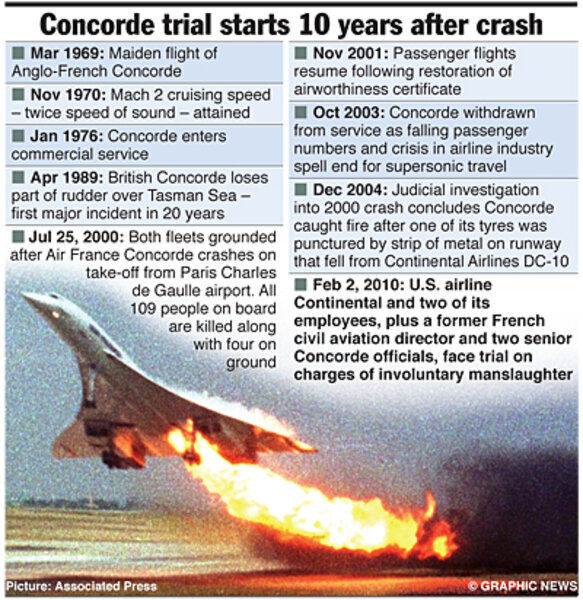
















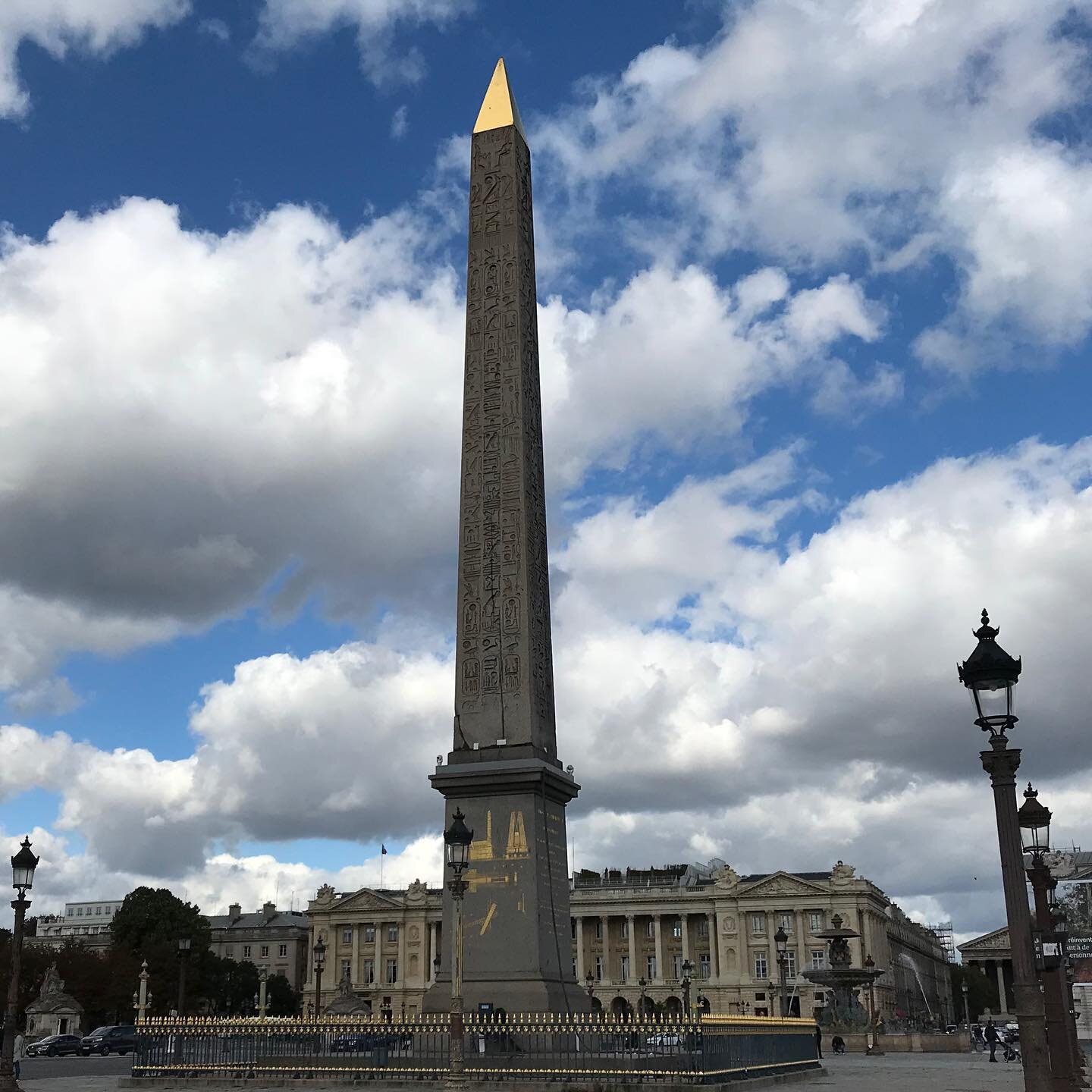
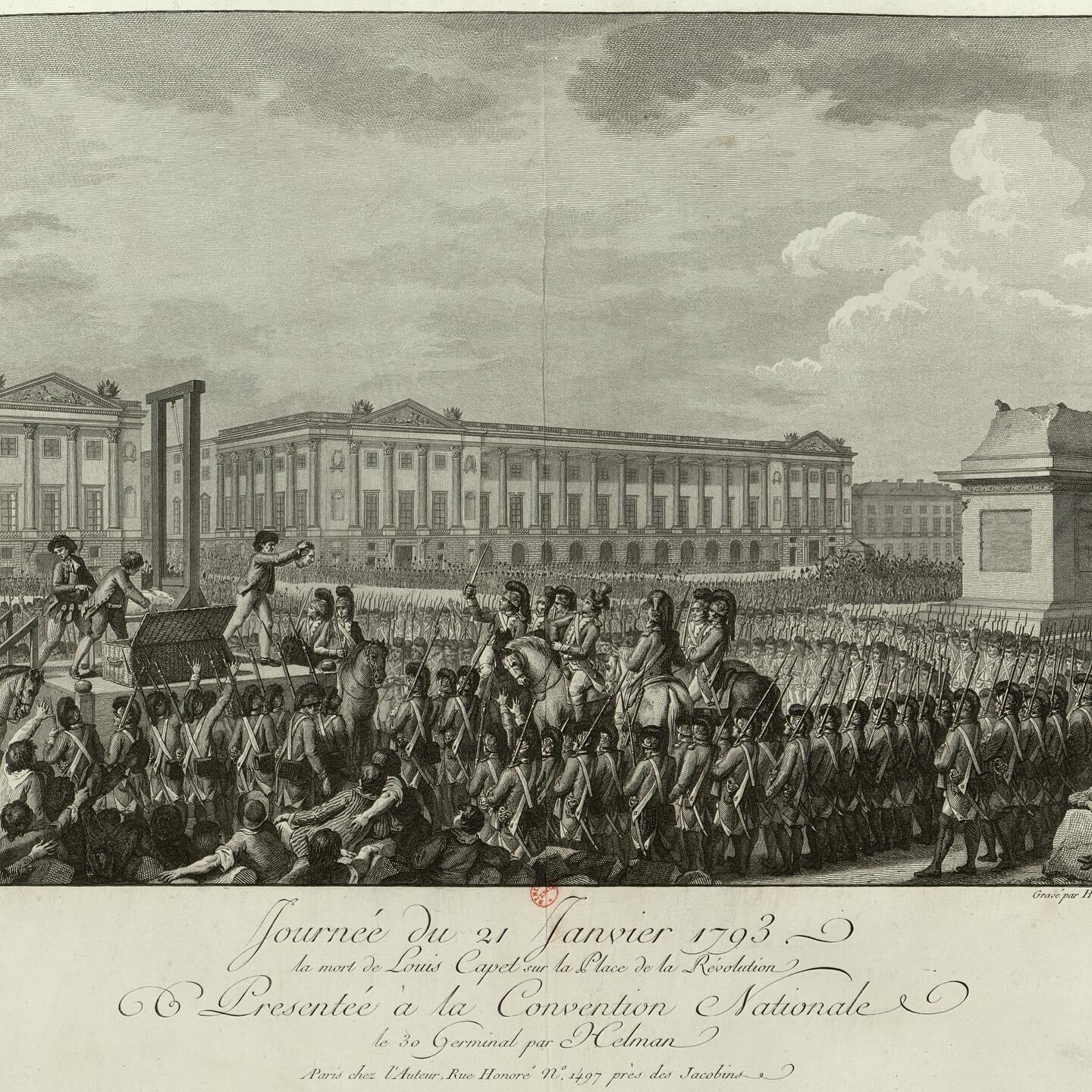
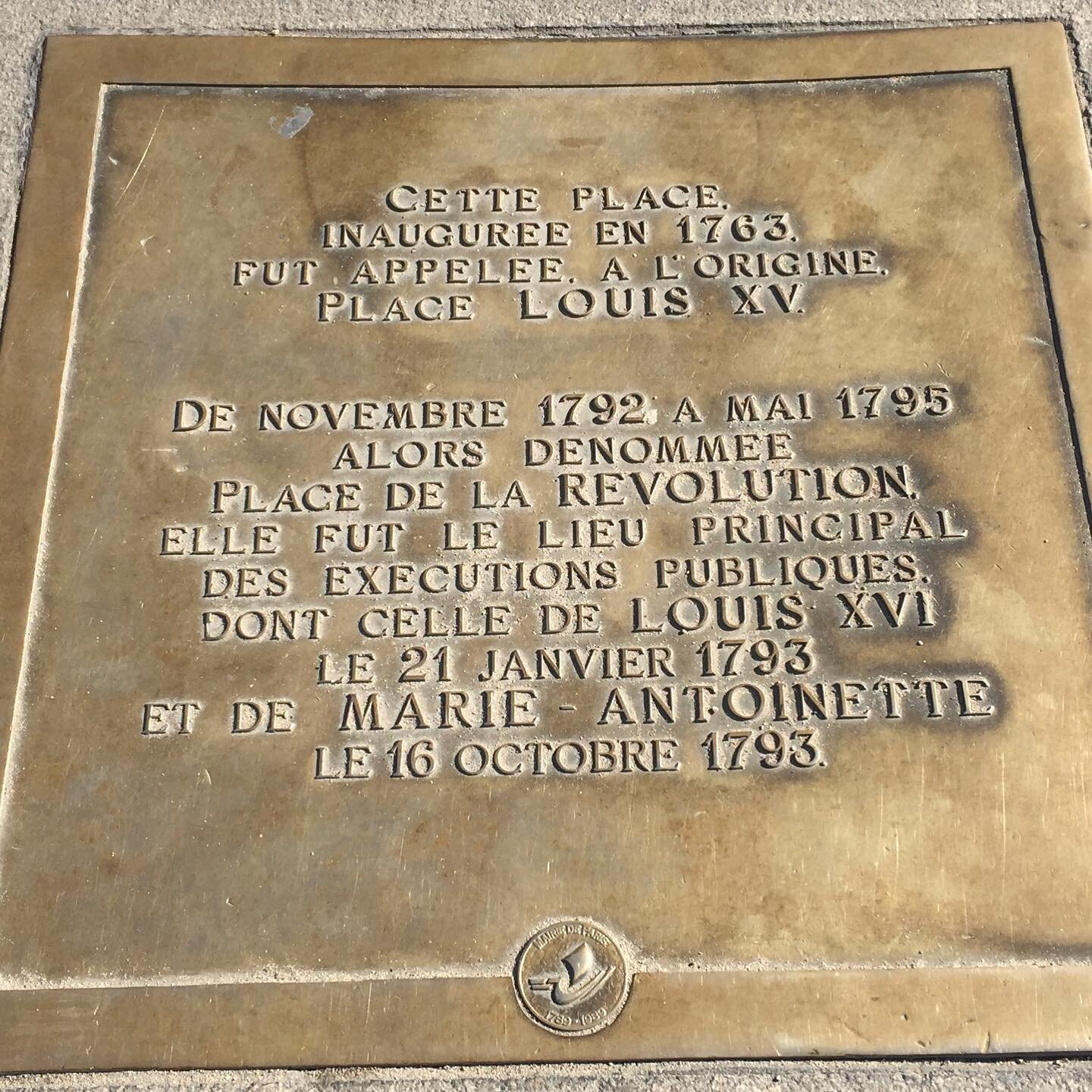
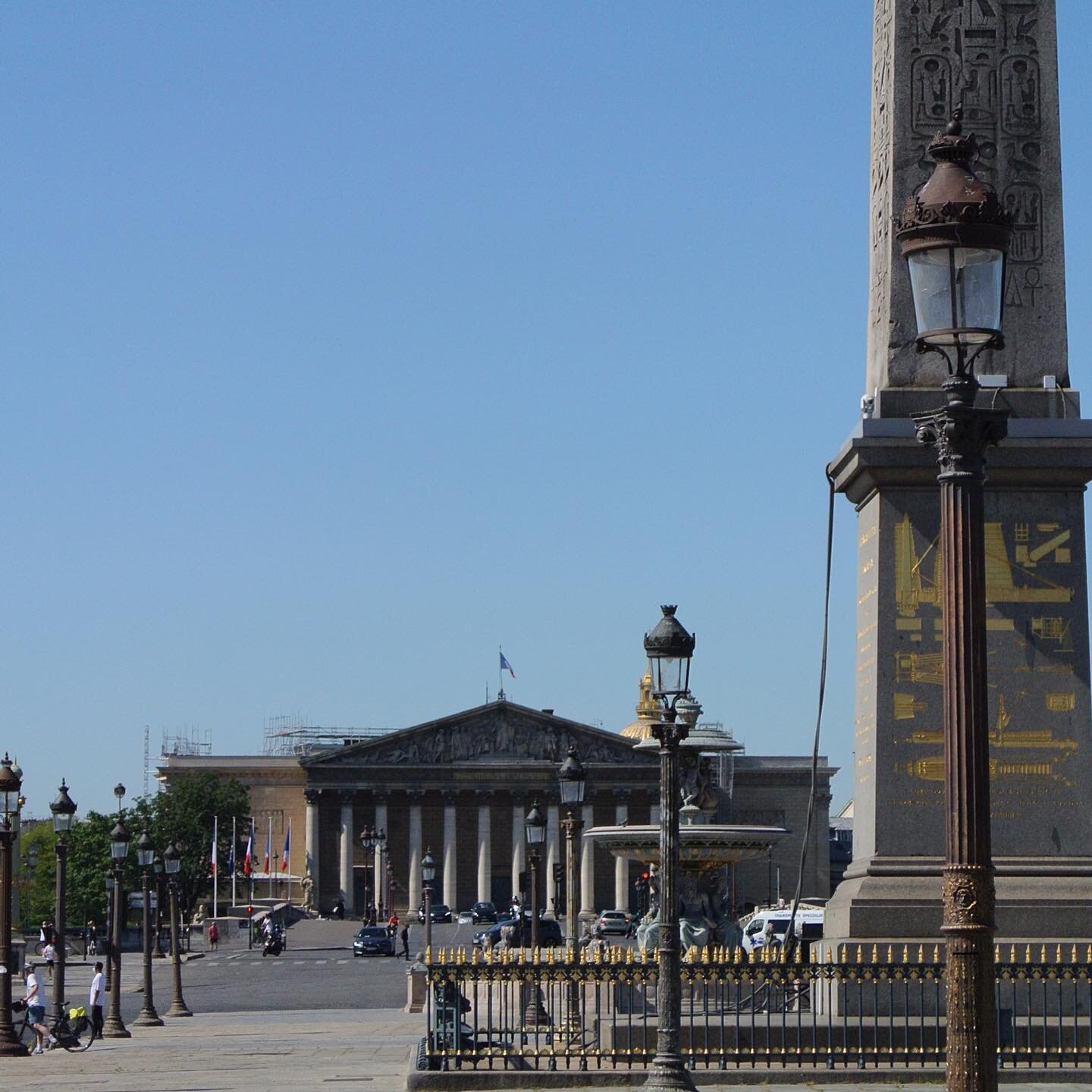



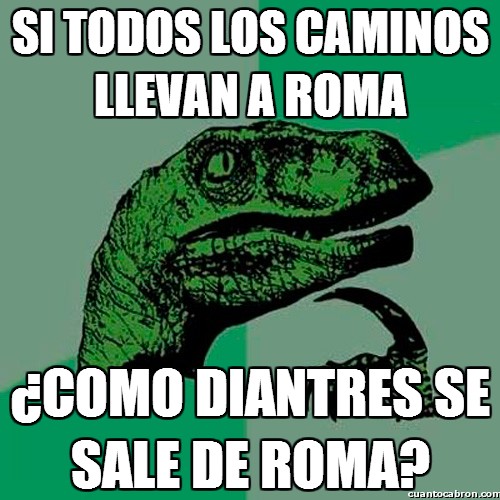




.jpg)

